Croatian Health Minister Beroš: Citizens' Behavior, Not Open Borders, Led To New COVID-19 Infections
June 20, 2020 — Croatian Health Minister Vili Beroš in an interview with RTL tried to downplay concerns about the increase in new COVID-19 infections, blaming the jump on citizens' relaxing too much and not open borders. Most of the new cases were imported.
Below is an abridged version of the interview.
How many are infected in Croatia?
If you remember, at the beginning of the crisis we said to communicate the numbers at 24-hour intervals, so it is relevant that there were 11 new cases today at 2 p.m., and for new data, we will see tomorrow at 2 p.m.
We urge citizens not to travel abroad, and we urge others to come to Croatia. Is that irresponsible?
I said that travel is not a problem, but a behavior. Therefore, we hope that tourists will try to come healthy and see how our citizens behave and that we will reduce the spread of the virus.
Is Split a new coronavirus hotspot?
There are imported cases, they have infected relatives. We're talking about personal contacts, and there is no local transmission. It is Split that shows how important it is to respect the measures: hand hygiene or sneezing or coughing. This prevents the spread of the epidemic. I could say that travel in itself is not a problem, the problem is behavior both outside and upon return.
Is Split's Civil Protection Directorate doing a good job?
I think they are doing it well. It found quick solution to the situation on Brac. People are returning from abroad to Split, and it still does not depend on the Directorate, but on the citizens themselves. The virus is all around us.
What about foreigners, that is, a woman who came on business and who is positive?
One case is not changing anything at the moment. It is clear that there are countries with a similar or better situation and nothing will change there, and we will consider measures for countries where it is worse.
Capak hugged at the conference where he was infected, so how can we expect the citizens to listen?
I wouldn’t say he’s relaxed, anyone can get in touch with a COVID-19 positive person. Prevention is important. I can also say that the circumstances were different, that there might not have been an infection, but caution can never be too much.
Is holding an election questionable?
We are watching the epidemiological situation from hour to hour and depending on it, we will think about all the other steps. The measures will be harmonized. If there is an epidemiological situation that allows it, the elections are going forward.
Health Minister Beros Comments on New Coronavirus Cases in Croatia
June 18, 2020 - Health Minister Vili Beros said on Thursday that the appearance of new coronavirus cases in Croatia over the last few days is not unexpected, which shows that caution is still needed. So far, there are no tourists among those infected who have come to vacation in Croatia.
"The fact is that the virus is still among us. The most important thing is that in all new cases, we know the way of infection, that the epidemiological service quickly detected all patients and that all necessary epidemiological measures were taken," Beros said on N1.
He points out that among the infected, there are no tourists who came to Croatia on vacation, but it cannot be ruled out that there will be.
"We opened up at one point, it was our decision and need, and if there is a resurgence of patients, we have ready measures that we can take," said Beros, who is attending an exercise in Dubrovnik to establish the Emergency Helicopter Medical Service during the summer season.
New data from the National Civil Protection Headquarters on the number of patients are expected at 2 pm, and according to the latest data, two new cases of coronavirus were discovered today in Istria, while there are at least four infected people from Zagreb's Hrvoje Pozar Institute.
Furthermore, in Split-Dalmatia County, out of a total of 66 processed tests, there are 3 newly diagnosed patients - two from Split and one from Solin.
"Three new coronavirus cases were confirmed in Croatia on Wednesday, and in recent days, we have inputs from abroad and local transmission of the virus within Croatia," epidemiologist Bernard Kaic from the Croatian Institute of Public Health told HRT this morning, adding that we relaxed too soon.
According to yesterday's data from the National Civil Protection Headquarters, there is one newly infected person from Split-Dalmatia County, and two from Zagreb. One came from Bosnia and Herzegovina, and the other is the contact of an infected person from abroad. But due to the number of people placed in self-isolation, more are expected to be infected.
Follow the news in Croatia on our dedicated page.
Analysis: Coronavirus in Croatia Compared to Other European Countries — May 13 Update
May 13, 2020 — Here’s another analysis of the situation in Croatia in relation to other EU member states as of May 11.
The central place for all information about coronavirus in Croatia is koronavirus.hr.
You can find some good visualizations of the pandemic in Croatia on the visualization of the coronavirus pandemic in Croatia Mireo and the visualization of the coronavirus pandemic in Croatia Velebit.ai.
A graphical representation of the number of deaths from or with SARS-CoV-2 virus per million inhabitants per country places Croatia among the five best-positioned countries, with the lowest proportional number of victims (the source is the Johns Hopkins University coronavirus database). Along with Croatia, there are Greece, Poland, Bulgaria and — according to available data, the most successful — Slovakia. The next group with a lower mortality rate is the Czech Republic, Norway, Hungary, Estonia, Finland, Slovenia and Romania. The worst has hit Belgium, Spain, Italy, and the UK. Compared to Croatia, due to its approach to measures to combat the epidemic, the often mentioned Sweden has about 15 times the number of victims per million inhabitants. Belgium has as many as 34 times more victims per million inhabitants.
Mentioning only the absolute numbers of registered infected persons or persons who have died from or in the presence of a new coronavirus by country does not give a true picture of the situation, given that there are huge differences in the population of individual countries. For example, Belgium with its 11.5 million inhabitants has 8,707 victims so far, while Italy with 60.5 million inhabitants has 30,739 victims, but Belgium has as many as 48% more victims per million inhabitants than Italy.
It can also seem that Germany with 7,569 deaths has a lot more victims than Sweden with 3,256, and in fact, the per million population Germany has 72% fewer victims than Sweden.
If we look at the state of the number of registered infected people on the same date, regardless of the onset of the epidemic in each country, as shown in the following figure, it is difficult to compare the development of the epidemic by country in parallel.
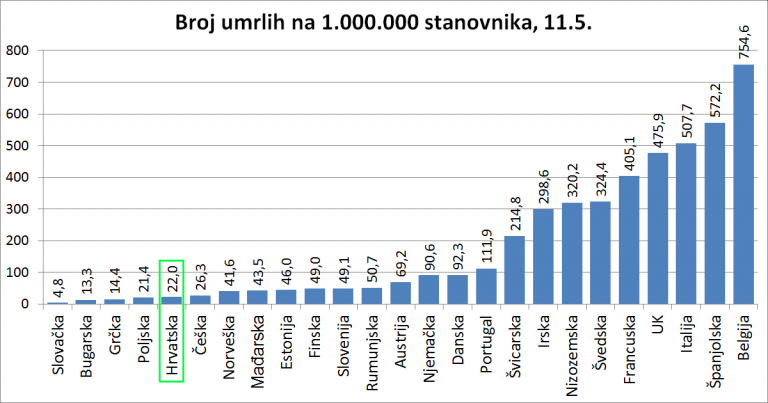
Mentioning only the absolute numbers of registered infected persons or persons who have died from or in the presence of a new coronavirus by country does not give a true picture of the situation, given that there are huge differences in the population of individual countries.
For example, Belgium with its 11.5 million inhabitants has 8,707 victims so far, while Italy with 60.5 million inhabitants has 30,739 victims, but Belgium has as many as 48% more victims per million inhabitants than Italy. It can also seem that Germany with 7,569 deaths has a lot more victims than Sweden with 3,256. In fact, per million Germany has 72% fewer victims than Sweden.
If we look at the state of the number of registered infected people on the same date, regardless of the onset of the epidemic in each country, as shown in the following figure, it is difficult to compare the development of the epidemic by country in parallel. The slope of an individual curve in a period speaks of the speed of the spread of the epidemic, as far as can be determined from confirmed infections. We do not know the number of unregistered infected people.
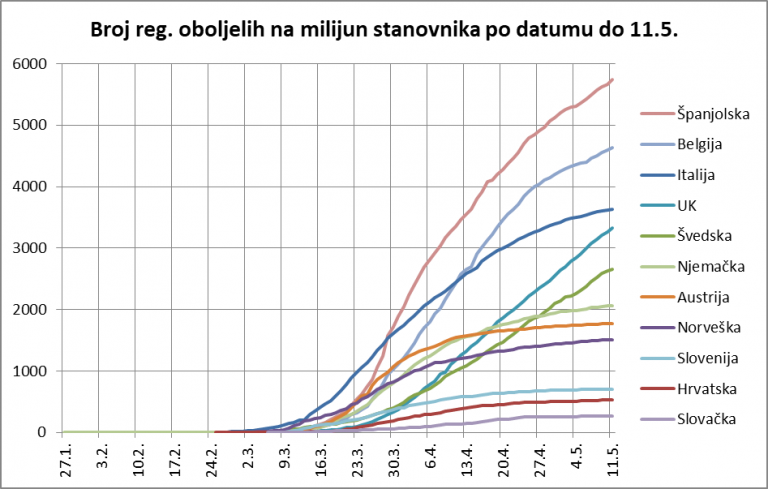
It can be seen that among the observed countries the epidemic first broke out in Italy. However, the growth in the number of patients in Spain (about a week later) was much faster than in Italy.
The number of patients in Italy grew to one million on March 30. Spain has the highest number of cases per million inhabitants among the observed countries, and the curve is just beginning to show a significant reduction in the epidemic.
The second fastest-spreading epidemic is Belgium, with a slightly lower growth rate than Spain, also with more significant signs of calming just begun last week. Italy, the third-largest country in terms of population per million inhabitants, has shown signs of calming down in the past three weeks.
The next two countries that currently have linear curves with no signs of calming down are the United Kingdom and Sweden. Sweden surpassed the number of registered cases per million inhabitants in Germany in early May, and will soon reach the number registered in Italy. Their own research indicates the likelihood of a large proportion of the population being infected but confirmed.
Slovakia and Croatia have had excellent control of the epidemic from the outset, and Austria, Norway, and Germany have successfully calmed the rapid growth that occurred in the week of March 23.
In the following chart, we offer an overview that begins for each country with the date when the infected person was first confirmed in that country. In this way, it is possible to compare the development and effects of epidemic control both in dynamics and in relative numbers per million inhabitants.
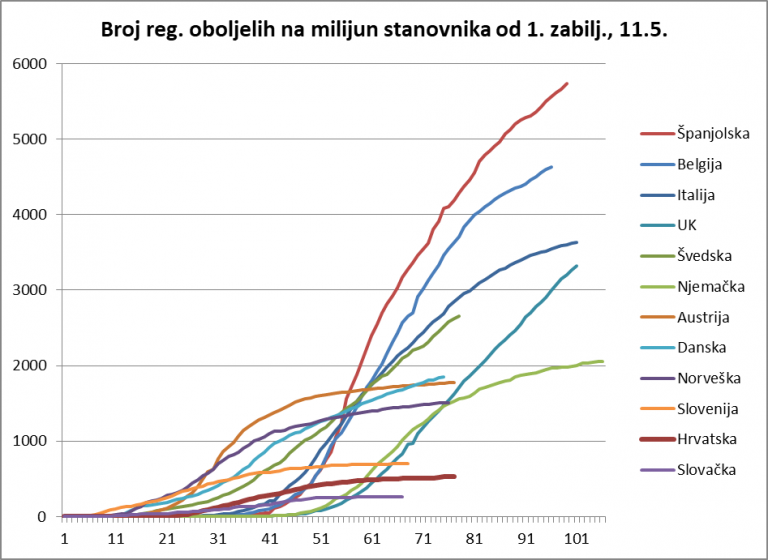
At first glance, two groups stand out among the observed countries. The left group is the one in which the epidemic developed relatively quickly after the first registered infected person in relation to the population: Austria, Norway, Denmark, Sweden, Croatia, and Slovakia. These are countries with a smaller population. The right group is the one in which more time has passed since the first registration of the infected person and these are countries with a larger population.
The first group shows a sharp increase in the number of infected in Austria, but also a very rapid reaction that reversed the course of the epidemic around the 32nd day, and even without "leveling" immediately achieved a consistent reduction in the number of newly infected. The epidemic has calmed down after about 50 days in Austria which, of course, has a big impact on deciding on further measures. The growth rate of the number of infected people from the 51st week is actually the same as in Croatia, except that in Croatia there is a significantly smaller number of patients.
The epidemic in Norway had a similar course with an even more abrupt start, but apparently with a quick reaction of the authorities, who reversed the trend also around the 32nd day and achieved a calming of the epidemic around the 45th day.
In Denmark, the epidemic began very similarly to Norway, the first calming occurred even faster, but after that, the linear growth continued at a rate higher than in Austria and Norway, and on the 70th day Denmark exceeded the number of registered cases per million inhabitants in Austria.
The same group is followed by Sweden, which initially did not have a sharp increase, but on the 55th day, it outgrew Denmark, Norway, and Austria in the number of registered infected persons. On the 66th day, it caught up with Germany, roughly following the development of the epidemic in Italy.
Seen in this chart, Croatia and Slovakia have maintained a very low slope curve almost from the beginning and have the lowest number of registered infected persons per million inhabitants.
In the group of larger countries, it is evident that the most difficult situation is in Spain, which after exponential growth until the 56th day of the epidemic on its territory managed to achieve linear growth first with a stronger slope, and then from about 62 days with a slightly milder but still large slope. Signs of calming the epidemic the week before last were somewhat disrupted last week.
It is similar in Belgium, which straightened the curve around day 54, but has since maintained a uniform but high (relative) increase in new infections with signs of calming the week before last, but a re-emergence of the epidemic last week.
Italy, whose exponential curve started about a week before the one in Spain, achieved a more moderate slope of the linear part of the curve around day 49 and shows a slight but continuous calming of the epidemic after about 81 days.
With a certain time lag relative to the first registered infected person, Germany achieved a curve similar to Austria with a change of trend around the 68th day, but its growth rate of the number of infected in the last part of the curve is still higher than in Austria.
The United Kingdom managed to straighten the curve after exponential growth around the 70th day, but to this day without any sign of calming down. With this increase in new cases, they will quickly catch up with Italy.
If we take a closer look at Sweden we can see a form of exponential growth in the number of infected that has turned into a linear one in the last three weeks.
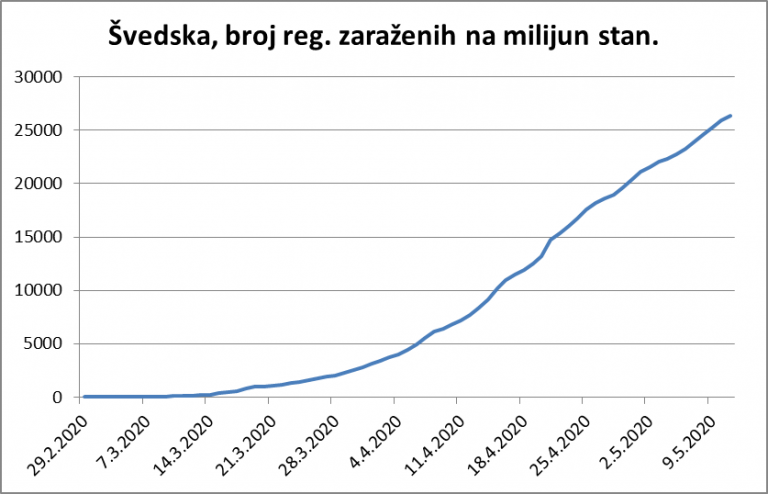
The following graphs will compare the dynamics of the epidemic by individual countries.
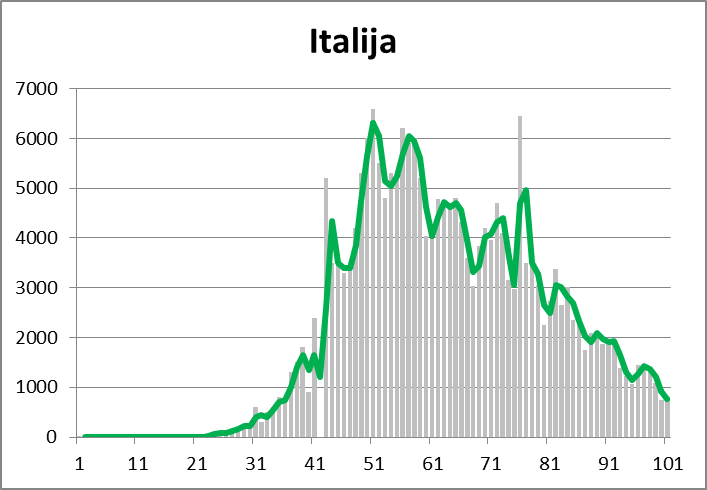
The curve shows in a different way a sharp daily increase in the number of newly registered patients until about the 50th day and then a very uniform and controlled calming.
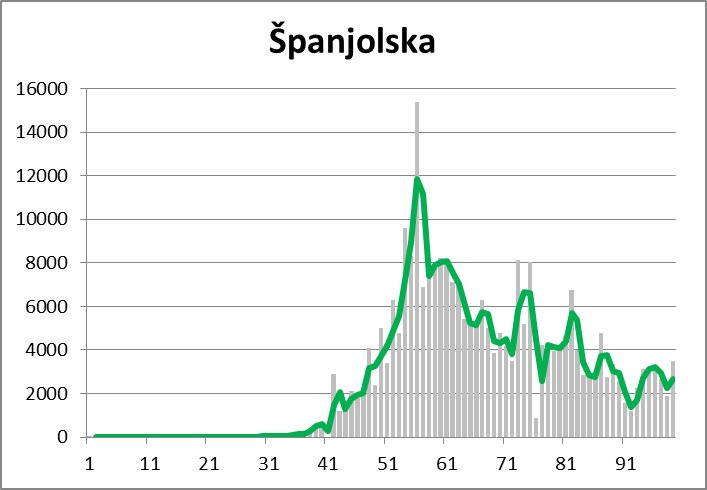
Spain, after an incredibly rapid spread of the epidemic, which reached as many as 15,400 newly infected on the 56th day, is very slowly lowering that number, and in the last week, this trend has been reversed.
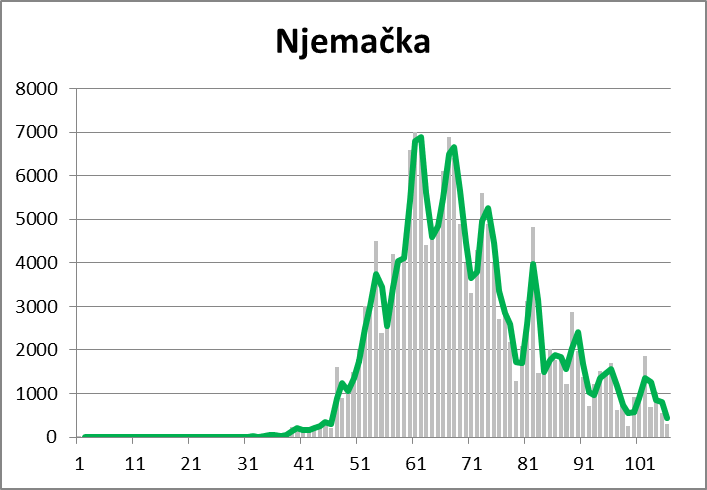
As can be seen in previous charts on the epidemic, Germany has very successfully reduced the number of new infections after reaching a peak between days 61 and 68, with the trend deteriorating slightly last week.
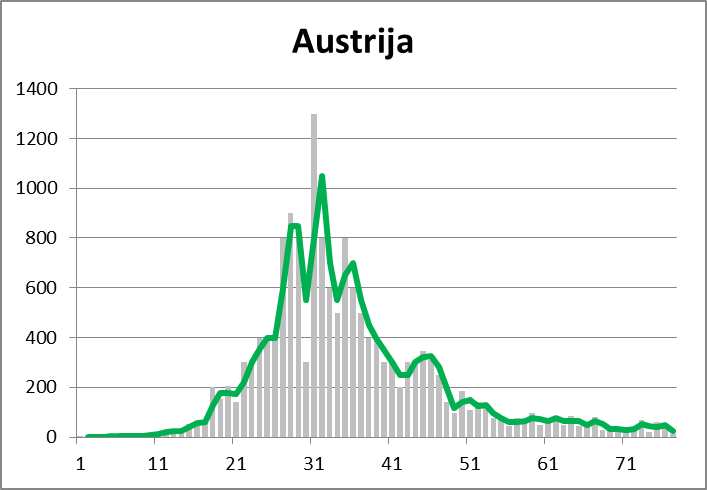
And this chart shows that Austria managed to stop and calm the epidemic very quickly.
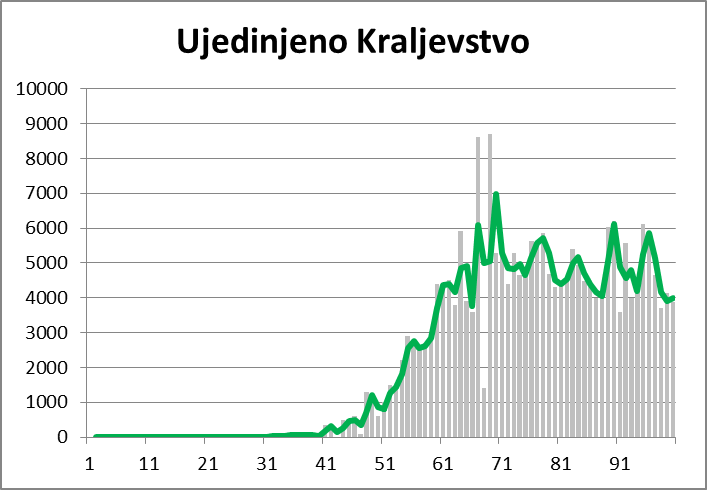
This chart contributes to the understanding of the UK curve as shown in the previous summary charts. After the exponential growth has stopped, the daily number of confirmed new infections is practically the same, about 5,000 per day, and there are no indications of a decrease.
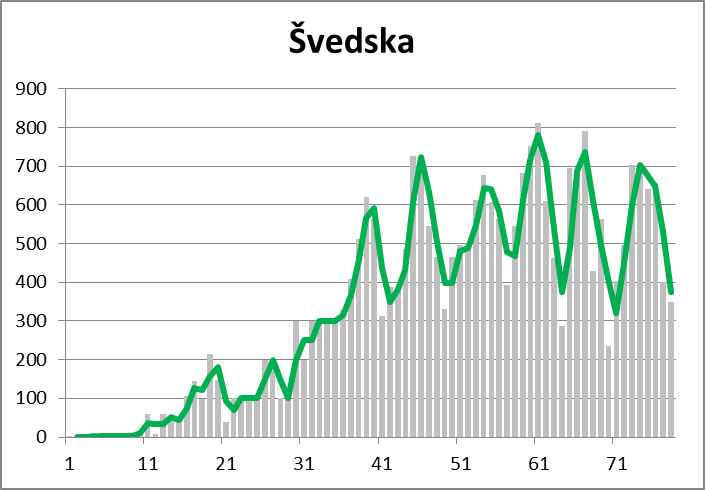
Similarly, the curve of the daily number of newly infected in Sweden otherwise shows the linear growth as shown in Figures 2 and 3, with the caveat that in this case an interesting approximately weekly periodicity is recognized.
Although the following graphs do not show exactly R0 (an epidemiological statistical indicator that indicates how much one infected person infects other people in a given period), very similar information can be read from them. The last three weeks are shown. The situation is all the more favorable because the daily value is no more than 1, and all the more unfavorable because this value is higher than 1. Accordingly, the trend indicators are colored in green (a favorable period when the epidemic subsides), yellow (threatening period around 1), and red (an unfavorable period when the epidemic spreads). The longer the red period compared to the green, the more unfavorable the situation.
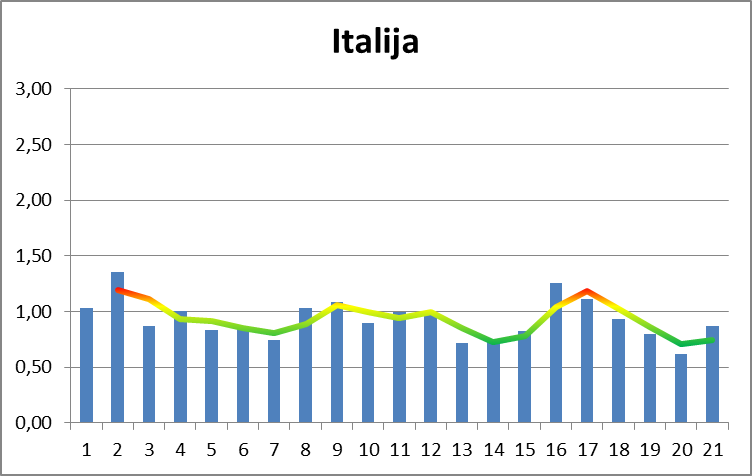
It can be seen that in Italy most of the time the curve is in the green area, which corresponds to the behavior of the curve in Figures 2 and 3, ie the trend of the epidemic subsiding.
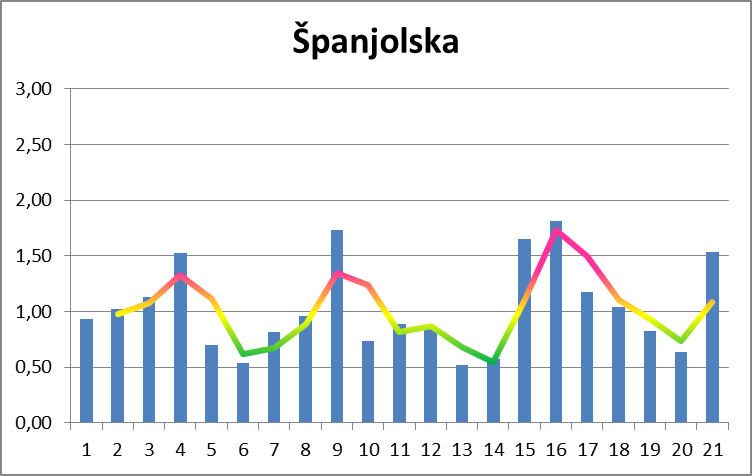
In Spain, this curve goes into the red area a lot, reaching over 1.5, which means that at that moment, two infected people infect three others.
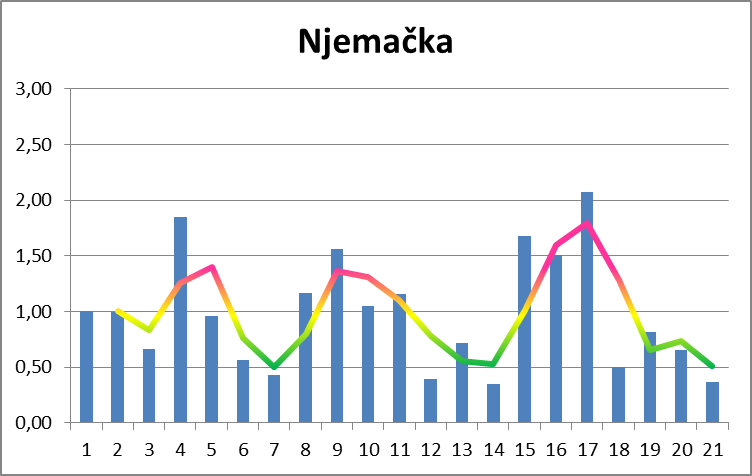
As German officials themselves have warned, the situation in Germany has deteriorated somewhat in the last week, as can be seen in this chart.
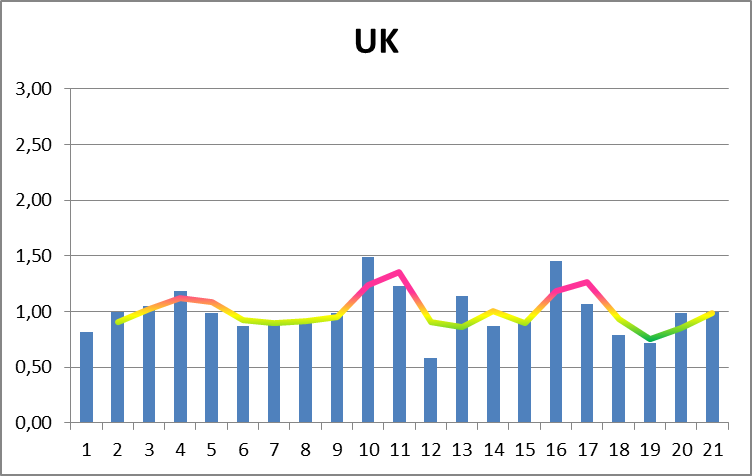
The situation in the UK is not good. The indicator generally ranges around 1, goes very weakly into the green, and more strongly into the red area. Therefore, the curve on the comparison charts for the UK is dire.
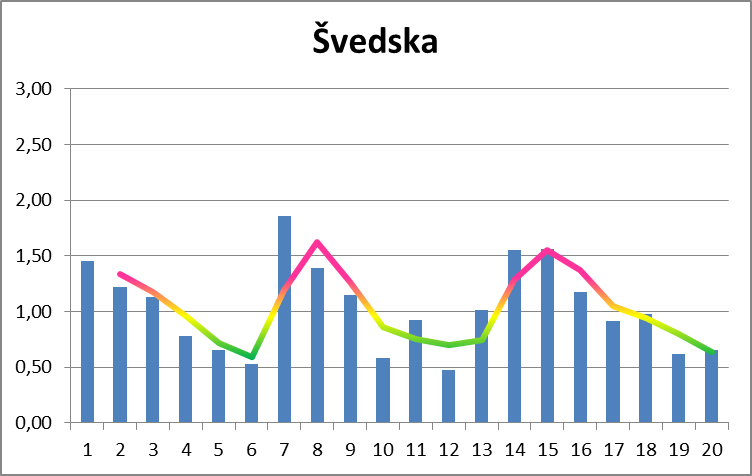
Sweden also shows variations in this presentation, and it can be seen that the indicator "spends" approximately the same amount of time in the green and yellow areas, which means that on average it is around 1.
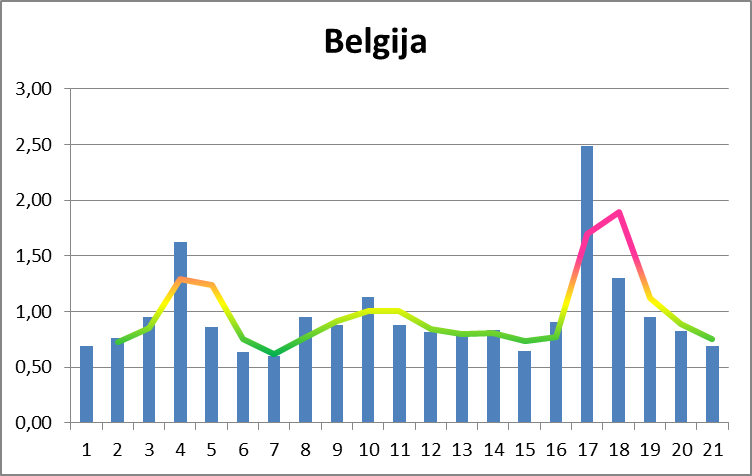
This graph also indicates that a major epidemic breakthrough has taken place in Belgium in the last week, and the previous two weeks are not particularly optimistic either, as the indicator was mostly around 1.
If we take a closer look at Croatia, we will see that the linear growth was already achieved around 22.3. (immediately after the earthquake in Zagreb), that an even better slope was achieved after 1.4., and that from 16.4. achieves a very successful calming of the epidemic. It could also be statistically concluded that the average recovery time of registered patients is between 3 and 3.5 weeks.
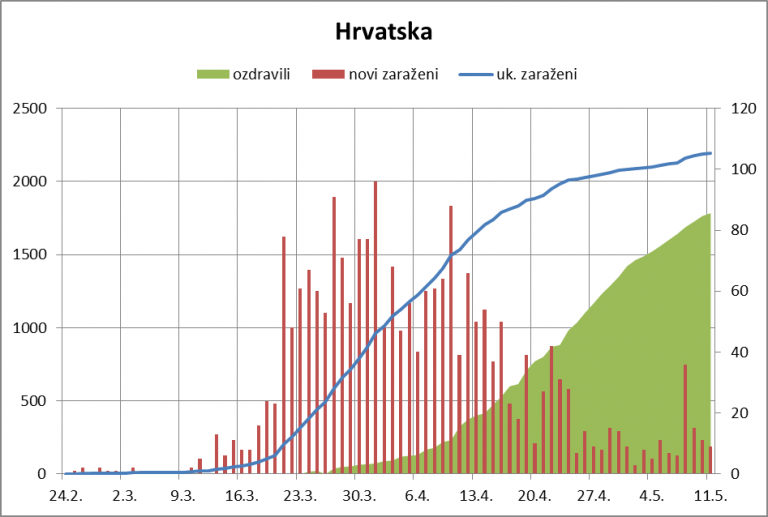
On the blue curve, it is easy to see how the high daily increment shown in the red columns after May 8, when the breakthrough on Brač was determined, is reflected.
An excellent general result of Croatia can also be seen in the graph showing the movement of the number of patients. This curve significantly reduces the pressure for health facilities, so it can slowly return the entire health system to normal when it performs all its functions.
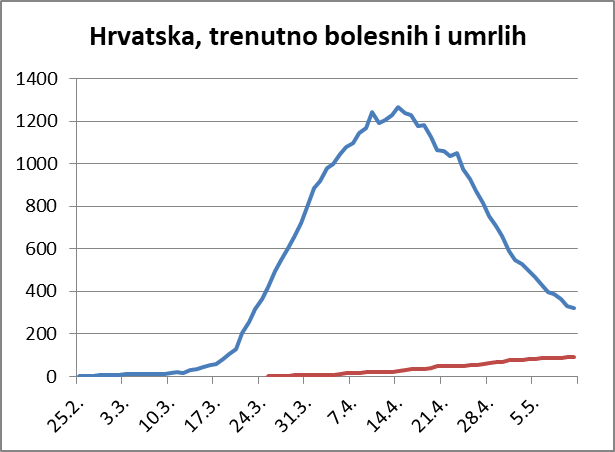
In these topics, the question often arises as to what is a good measure in testing and whether we test enough. An excellent graphical representation of the ratio of testing per million inhabitants to the percentage of positives shows who tests optimally and who does not at all. If you are around and below 10% positive, you have found a good measure - Croatia is.

When you look at the overall picture and compare it with other countries, you can clearly see that Croatian epidemiologists have excellent control of the epidemic. It is now up to other experts to make the best use of this favorable situation for the benefit of Croatian citizens.
Others rightly rank Croatia among the countries that have successfully defeated the coronavirus.
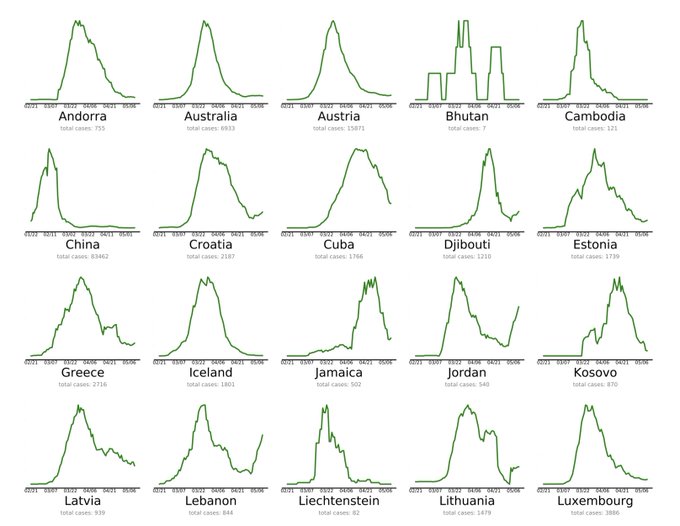
Given that decisions on crisis management, especially in the phase of easing anti-epidemiological measures, are not only health but also political, further careful monitoring of the situation and comparison with political decisions and health outcomes in other countries is needed.
Of course, every country can ask itself what its long-term perspective is in these new circumstances that will not disappear. States, which have curbed the epidemic in the sense that they have ensured that their health system can control the situation, develop further strategy than those who still have to make every effort to maintain the functionality of the health system.
In all this, it is necessary to take care of the economic consequences of the crisis - lower estimates of the fall in GDP by EU member states. Due to excessive exposure to tourism, Croatia is unfortunately at the very top.
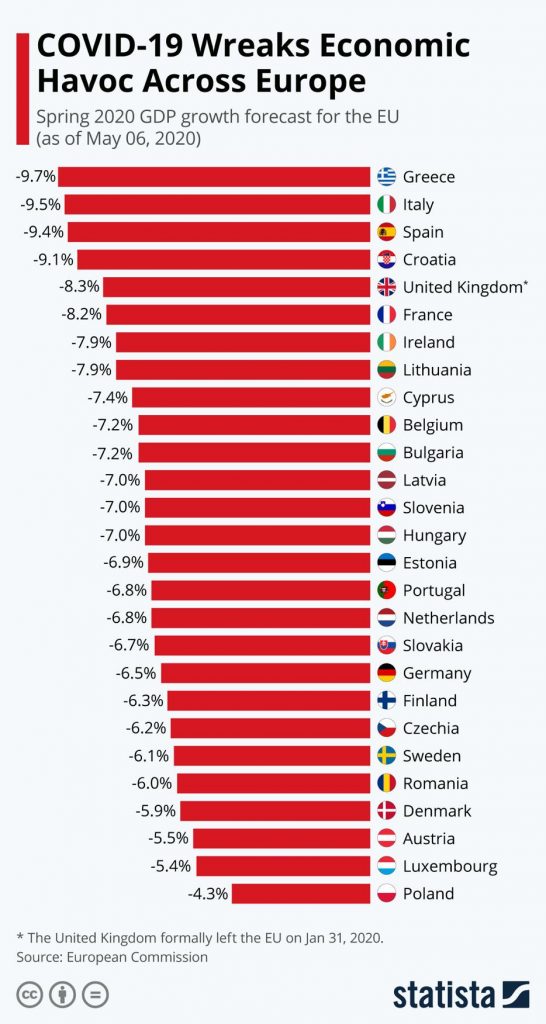
Analysis: Coronavirus in Croatia Compared to Other European Countries — May 12 Update
May 12, 2020 — With the debate over relaxed measures against coronavirus spreading around the world, it may be worthwhile to see how Croatia’s neighbors and larger countries on the continent have handled the pandemic.
Here is another detailed overview of coronavirus measures in the EU, UK, Norway, Switzerland, and the Western Balkans.
You can also follow the measures taken in the fight against coronavirus and compare it with other countries here. The interactive government austerity index graph is based on responses that include travel bans, school and job closures, measured in values from 0 to 100 (100 = most stringent measures). This index simply records the number and severity of policy measures adopted and should not be construed as “scoring” the appropriateness or effectiveness of a country's political response.
[Important: all these planned measures are valid provided that the epidemiological situation does not worsen.]
German Chancellor Angela Merkel said at a session on April 30 that all religious services have been re-enabled. As of Sunday, May 3, some churches have already opened their doors after more than a month of isolation, and in order for believers to guard against infection, it is mandatory to maintain social distance and wear masks.
Singing and physical contact, such as handshakes, are currently prohibited. In addition to religious buildings, children's playgrounds, individual schools, museums, exhibitions, galleries, zoos and botanical gardens have been reopened. Hairdressing salons have been operating since May 4, but under strict epidemiological rules.
Also, a slightly larger portion of hospital capacity should be vacated again due to scheduled surgeries as most of them have been delayed in recent weeks.
Merkel has confirmed that large, public events will not be allowed until August 31. This applies to all major sporting events, local celebrations, concerts, festivals and entertainment events.
In addition, she said the federal and state governments would not make a decision on catering at the next meeting on May 6, but would focus on further easing measures for all schools, children’s centers and sports facilities, assuming the pandemic allows it.
Finally, politicians discussed labor market data where the profound impact of the pandemic will have on the German economy. They concluded the topic by stating they firmly believe that it is now most important for the economic and social interest to take a step forward. Although there is growing pressure from business groups and some regional governments that want to start economic life faster, Merkel warned that opening up too quickly would risk triggering a second wave of infection. Therefore, caution remains a key imperative while adhering to prescribed hygiene measures.
The Robert Koch Epidemiological Institute believes Germany is well on its way to controlling the coronavirus epidemic and urged citizens on April 28 to continue to adhere to rules to combat the spread of the infection to keep the country in a relatively good position. Chancellor Angela Merkel called the current fight against the pandemic a "fragile temporary success.”
Smaller bicycle shops, bookstores and shops opened on April 20. Also, on April 23, a measure was introduced to wear protective masks across the country. Cities report that citizens respect this obligation. Wearing masks was initially recommended by the federal government, but the provincial authorities turned them into an obligation.
EU citizens, as well as citizens of the United Kingdom, Iceland, Liechtenstein, Norway and Switzerland, are allowed to travel through Germany to reach their home country if no other connection is possible. Border controls between Germany and Italy, Spain, Austria, Switzerland, France, Luxembourg and Denmark have been introduced and extended until 15 May. All German citizens, EU citizens, citizens of countries that have signed Schengen agreements or individuals living in Germany must undergo a two-week mandatory quarantine upon return to residence in Germany, after a few days abroad, with certain exceptions.
NOT CLOSED in Germany:
- retail sale of food products, weekly markets pick-up, delivery and delivery services, markets, pharmacies, drug stores, drugstores, petrol stations, banks and savings banks, post offices and other central facilities such as dry cleaning, laundry, newspaper sales, construction, gardening and pet and pet markets, and wholesale. For those areas, Sunday sales bans should be lifted until further notice.
- Following the April 15 decision, all stores with up to 800 square meters of retail space, as well as - regardless of retail space - car, bicycle and bookstore dealers, may reopen.
- The opening of these facilities is subject to hygiene, access control and queuing. Service providers and craftsmen can continue to work. All health facilities remain open, taking into account the increased hygiene needs.
- Among service companies where physical proximity is necessary, hairdressers should first prepare for this by undergoing hygiene, access control and queuing, as well as the use of personal protective equipment. From May 4, I can continue working.
CLOSED TO THE PUBLIC
- Catering companies, where it is still possible to pick up food and take it home or deliver it.
- Personal care service companies such as hair salons, beauty studios, massage practices, tattoo studios and similar companies because physical proximity is crucial in this area. Medically necessary treatments remain possible.
- Cafes, clubs, discos, pubs and similar establishments.
- Theaters, operas, concert halls, museums and similar institutions.
- Fairs, exhibitions, cinemas, leisure parks and animals and leisure providers (outdoor and outdoor), special markets, arcades, casinos, bookmakers and similar facilities
- Prostitution centers, brothels and similar establishments.
- Sports on and in all public and private sports facilities, swimming pools and entertainment pools, gyms and similar facilities.
- All other retail outlets not mentioned elsewhere in this document, especially outlets.
BANNED
- Big events at least until August 31, 2020.
- Meetings in clubs and other sports and entertainment facilities as well as taking advantage of offers in adult education centers, music schools and other public and private educational institutions outside the school as well as bus travel.
- Group celebrations in public places, in apartments and private facilities.
- Visualization of coronavirus data in Germany
Switzerland opens in three phases. Service activities, such as hairdressers and physiotherapists, began operations on April 27th. Elementary schools opened their doors on May 11, and from June 8, high school, vocational and university classes will be reintroduced. The Federal Council will make a final decision on May 27, 2020. Restaurants and bars will remain closed until June 8.
Switzerland in an agreement with the FDFA, (Federal Department of Foreign Affairs) the FDHA (Federal Department of Home Affairs) defines high-risk countries or areas. As of March 25, all countries are currently considered high-risk countries or territories, with the exception of the Principality of Liechtenstein. People from high-risk countries and regions will be denied entry to Switzerland, but exceptions are possible, for example for people living or working in Switzerland.
The Federal Council gradually eased the following measures on April 27:
- Hospitals will be able to perform all surgeries and medical studies again, hairdressers, massage parlors, beauty centers, relaxation shops, shops or garden centers and flower shops will be able to continue their activities.
- Restrictions on the entry of all persons into Switzerland except those of the Principality of Liechtenstein
- The Federal Council is taking steps to restrict entry into Switzerland. The Federal Department of the Interior (FDHA), in collaboration with the Federal Ministry of Foreign Affairs (FDFA), defines countries and regions that are designated as at risk. Currently, all countries and regions except the Principality of Liechtenstein are considered risky. This regulation shall apply for a maximum of six months.
Gathering in a public space
On March 21, 2020, the Federal Council banned the gathering of more than five people in a public space. Based on data on mobile phones, we can check whether the population meets this provision.
Education system
- Lectures in schools, universities and other training centers are still banned. If the situation allows, compulsory schools will reopen on 11 May 2020. From 8 June 2020, secondary, vocational and university schools will be reintroduced. The Federal Council will make a final decision on May 27, 2020.
- Until the reopening of the compulsory school, the cantons will have to create care services for children who cannot be cared for privately. For this purpose, they cannot resort to persons who are particularly at risk.
Expected mitigation of measures in the area of services, retail trade and social activities
- In the retail and services sector from April 27, 2020, but under strict conditions.
- trading and home craft and gardening centers, garden shops, structures that offer body contact services such as hairdressers, massage parlors, tattoo studios, and beauty centers will be able to continue the activity.
- Healthcare professionals will again be able to perform all outpatient interventions, even those that are not emergency. This applies, for example, to doctors and dentists who practice studies, physiotherapists or medical masseurs.
- Hospitals will again be able to perform all interventions and reopen their outpatient offerings.
The following will be banned or closed:
escort or prostitution services and erotic places
For the social and family environment, on April 27, 2020, mitigation occurred:
The implementation will no longer be limited to the family circle
From 11 May 2020, the Federal Council also plans to relax the provisions relating to the inpatient medical sector.
Events and structures
The Federal Council continues to ban public or private events, including sporting events and corporate activities. All publicly available facilities remain closed, especially: restaurants, camping, bars, discos, nightclubs and erotica. Recreational and entertainment facilities, especially museums, libraries, cinemas, concert halls, theaters, playrooms, sports centers, gyms, swimming pools, spas, wellness centers, ski resorts, zoos, botanical gardens and wildlife parks
As planned, on June 8, museums, zoos and libraries, for example, will be able to reopen. By that date, the ban on gatherings must also be eased. The Federal Council will decide on these shortcomings on May 27, 2020.
However, the Federal Council believes that large demonstrations are unlikely to take place before the end of July 2020.
So far, the following structures and events have been excluded from the ban: grocery stores and other shops, if they offer groceries and items for everyday use (eg kiosks, gas station shops), self-service shops, dining rooms, meal delivery services and catering facilities for hotel guests, pharmacies, pharmacies and medical supplies stores (eg glasses, hearing aids), offices and post offices, points of sale of telecommunications service operators, banks, petrol stations, railway stations and other public transport facilities, workshops for means of transport, public administration ( including deprivation of liberty), social facilities (eg counseling centers), health facilities such as hospitals, clinics and medical offices, as well as studies and facilities of health workers under federal and cantonal law, hotels and accommodation, caravan and camper rest areas for long-term rental or nomads
These facilities must also continue to comply with the recommendations on hygiene and behavior. This may mean, for example, that the number of people present must be limited in order to maintain the required distance.
For deprivation of liberty (prisons), it is recommended to adapt measures to reduce the risk of transmission and fight against coronavirus (COVID-19) to the recommendations of international organizations, especially those of the World Organization. Health (WHO) and the Council of Europe.
In certain situations, the cantons may allow restrictive derogations from this prohibition. These deviations require an overriding public interest (eg for training grounds and in case of supply problems) and extensive preventive measures must be followed.
Visualization of coronavirus data in Switzerland
Larger shops and hairdressing salons started operating on May 2, since when it is allowed to gather up to ten people in one place, as well as to open shopping centers whose owners at this time the authorities sent requests for work on Sundays. Austria plans to allow the reopening of churches and restaurants by May 15. Austrian Tourism Minister Elizabeth Koestinger said Austrian hotels and swimming pools would open on May 29th. Museums should start operating in mid-May, and major public events, such as concerts, only at the end of August. Although they relaxed their measures, at the same time they introduced the obligatory wearing of masks when going to the pharmacy and supermarkets at the beginning of April. After two weeks, the same measure was extended to wearing masks in public transport and in all shops that have been allowed to work again since April 14. Recall that Austria was one of the first countries in Europe to start easing its preventive isolation measures.
Entry into Austria is only allowed at certain border crossings and under certain conditions. Anyone entering Austria from Germany, Hungary, Italy, Liechtenstein, Slovenia or Switzerland, or anyone who has been in an area for which the Austrian Ministry of Foreign Affairs has issued travel warnings in the last 14 days due to COVID-19 (including the UK), must present a medical certificate with the results of microbiological tests in English, French, German or Italian not older than 4 days. Have Please note that ski resorts and accommodation in the provinces of Tyrol, Salzburg and Vorarlberg are closed.
Traffic restrictions
Going to public places is strictly forbidden.
Quarantine measures in certain areas
In Tyrol, the valley of Paznaun, st. Anton am Arlberg and Sölden are in quarantine. No one is allowed to enter or leave the parishes. Exceptions are when it comes to covering basic services, providing basic services or a job.
Restrictions in trade, services and catering
The entry ban applies to retail and service companies, leisure and sports companies and all catering companies.
The exceptions are grocery stores, pharmacies, drugstores, post offices and banks. Food supply is guaranteed through supermarkets and delivery services.
Small shops selling goods and craft businesses
From April 14, small goods stores and craft businesses may reopen.
Restrictions in school, colleges, and universities
Classes exist in schools from 16.3. Primary and lower secondary schools are open only to those students whose parents have to work outside the home and whose children are not cared for at home or those students whose parents are unable to provide home care for other personal reasons.
Universities and colleges have shifted their teaching operations to virtual teaching, distance learning and home learning.
Restrictions in kindergartens
Kindergartens will continue to care for children whose parents are urgently engaged in professional activities and for whom no other childcare options can be found.
Restrictions on hospital visits
Relatives of people who are hospitalized are asked to refrain from visiting patients or to keep them to a minimum. Telephone contact is also recommended here.
Travel restrictions
Internal border controls have been introduced to curb the spread of Corona virus. Entry into Austria is only allowed at certain border crossings and under certain conditions (eg medical certificate).
Visualization of coronavirus data in Austria
On April 30, the Slovenian government passed a new decree lifting the ban on moving outside the municipality of permanent or temporary residence for services or goods. She also informed the public on April 29 that she would gradually release measures for kindergartens and education on May 18. So kindergartens, primary schools for the first three grades and secondary schools last year will open their doors first. Then the students of the 9th grade of primary school will come to the schools, and everyone else will finish their education from home. Mass events with large numbers of people are unlikely to be possible until a vaccine or drug for COVID-19 is discovered and started. Government spokesman for the corona crisis Jelko Kacin told Slovenian Television on April 27th that the government would make its next major decision on easing restrictions during the epidemic around May 12th. Also, on Sunday, April 26, President Pahor said that the coalition government of Janez Janša and the parliament performed excellently during the pandemic, and praised the citizens for adhering to protection measures. Thus, from Saturday, April 25, the services of insurance companies are available again, laundries, mechanics and vulcanization services are open, and from Tuesday, April 28, weddings are possible, but with a limited number of people, mostly in the presence of newlyweds and godparents. In Slovenia, the ban on leaving home municipalities is still in force, the abolition of which is being considered only as an option for May. It is especially emphasized that mass gatherings are still banned. On April 23, the government decided to continue the ban on air traffic - it is forbidden to perform international air transport of passengers from all countries to Slovenia, including within the European Union.
All passengers crossing the border with Slovenia will be notified by SMS about the protection measures in force in the country regarding coronavirus. Borders with neighboring countries are, with some exceptions, closed. As of April 12, a seven-day quarantine has been introduced for all persons entering Slovenia, with certain exceptions.
Currently banned activities
The temporary ban on public gatherings at public gatherings and public events and other events in public places in the Republic of Slovenia has been in force since 20 March.
Most public institutions are closed (libraries, museums, cinemas, galleries, etc.).
The ban on movement outside the municipality of permanent or temporary residence applies from 30 March
Public bus and rail transport, gondolas and cable cars have been suspended since 16 March
The delivery and sale of goods and services directly to consumers in the Republic of Slovenia has been temporarily banned since 16 March. These include: accommodation, catering, wellness, sports and recreational, cinematographic, cultural, hairdressing, cosmetic and pedicure services, games of chance and other similar activities.
temporary bans exclude the sale of goods and services to consumers, pharmacies and shops predominantly by food, including the sale of agricultural products on farms.
From March 30, 2020. k only vulnerable groups (eg people with disabilities, pregnant women) can commit. Retirees can only shop at that time
Disinfection of multi-apartment buildings is mandatory from March 29
The maximum allowable prices of protective and other medical equipment were set in March
Education measures
As of Monday, March 16, all educational institutions in Slovenia are closed (except for institutions that work with adolescents with emotional and behavioral disorders).
Organized group care for children is prohibited.
Measures in work environments
The Ministry of Labor, Family and Social Affairs and Equal Opportunities has published clarifications and recommendations to employers regarding the assignment of work from home and other work in exceptional circumstances when the lives and health of people or property of employers are endangered.
Measures in administrative units and judiciary
Until further notice, the operations of administrative units are limited to performing urgent tasks.
Measures in retirement homes
A complete ban on visits to retirement homes was introduced due to the growing number of coronavirus patients in Slovenia and to protect the health of residents.
Visualization of coronavirus data in Slovenia
As of May 11, the government has opened museums, galleries, cinemas and theaters by easing gradual measures. For these, but also sports, religious and other public events, as well as for weddings or training of athletes, the number of participants is limited to a maximum of one hundred people. In addition, as of May 11, clear rules have been established for the work of hairdressers, pedicurists, masseurs and other similar trades, as well as the work of large shopping centers, which opened their doors that day, while primary, secondary and art schools can be partially opened. . From May 11, elementary school graduates can return to schools along with high school and conservatory graduates. Class participation will not be mandatory and can be held in a group of up to 15 people. From Tuesday, May 5, it is mandatory to wear protective masks for kindergarten teachers, children, students, pupils and teaching staff during school lectures. On April 14, immediately after Easter, the Czech government approved a plan to open smaller stores on April 20. Restaurants and shopping malls will start operating on June 8. As of April 24, religious ceremonies involving a maximum of 15 people are allowed. Also, as of March 19, 2020, all persons are prohibited from staying in public areas without masks. Also, entrance exams for colleges will be held in June, and all exams in final grades (such as graduation) will be held after June 1st.
As of May 1, the government orders a ban on entry for all foreigners who do not have a temporary stay longer than 90 days or residence in the Czech Republic, as long as the state of emergency lasts, with exceptions. Earlier, as part of mitigating measures against the spread of coronavirus, the government expanded the range of foreign nationals who can enter the Czech Republic to EU citizens who come to do economic activities and students from EU countries. Also, Czech citizens and foreign nationals with an entry permit can avoid a 14-day quarantine when entering the country, if they enclose a certificate that they are negative for coronavirus no older than four days, and the decision takes effect on April 27.
April 20
Universities (scientific and academic institutions) - individual activities within university studies for students in the last year of study always have a maximum of 5 students.
Individual consultations; individual examinations, especially state final or rigorous examinations that complete studies properly; individual presence in laboratory, experimental, artistic and practical activities and practices or clinical and practical instruction, required for the completion of a bachelor's, master's or doctoral studies, or the completion of a bachelor's, master's or doctoral thesis); individual visits to libraries and study rooms for all years for the purpose of receiving or handing over only study literature.
Crafts with business premises.
Markets and markets for farmers, other markets and markets.
Outdoor training activities for professional athletes.
Wedding for up to 10 people in specific hygienic conditions.
April 27
Facilities up to 200 m2, unless they are in shopping centers above 5000 m2 with the exception of facilities with a separate entrance from the outside (this does not apply to facilities that will be opened at later stages)
The license does not apply:
For spaces located in shopping malls above 5000 m 2 unless they have a separate entrance from the outside.
For establishments where the service provider contacts the customer's body surface, barber shop, hairdresser, pedicure, manicure, solarium, cosmetics, massage, regeneration or refurbishment, which conducts trade in which the integrity of the skin is compromised.
Cafes, delicacies, wine shops, pubs, except sales without consumption in the store and sales with consumption through the window.
Restaurants, pubs, buffets with the exception of sales through the window for rent.
Catering employees with food for the public.
May 11
Students of high schools, conservators and universities - exclusively for graduation, final exam and graduation.
Individual classes in primary art schools and language schools with the right to state language exams.
Regular classes in schools in children's homes with schools, educational and diagnostic institutions.
Facilities up to 1000 m2, unless they are in shopping centers higher than 5 000 m2 with the exception of facilities with a separate entrance from the outside (this does not apply to facilities that will be opened in the following stages).
Operation of a driving school (theory and other forms of teaching up to 5 people).
Fitness centers and gyms without the use of facilities (showers, locker rooms) under precisely defined conditions.
May 25
Possibility of personal presence of primary school students and their organized and free activities of an elective nature in the form of school groups - 15 children in a group (one child on a bench) are recommended, without the possibility of changing the group, mandatory, and then curtains in common school areas.
Teaching and education in primary art schools, language schools with the right to state language exams, courses in entertainment centers and homes for children and youth - a maximum of 5 children.
Restaurants, pubs, cafeterias, cafes, wine shops, pubs for sale through windows and outdoor (summer) gardens.
Hairdressing services, hairdressing services, pedicures, manicures, solarium, beautification, massage, regeneration or remodeling.
Museums, galleries and exhibition halls in accordance with certain conditions.
Zoos (outdoor areas only).
June 1 (maybe)
Possibility of graduation and final exams and matura at conservatories and faculties.
Limited ability to conduct practical classes (vocational training) in secondary and tertiary vocational schools - conditions similar to those of school groups.
June 8
All shopping malls
Facilities larger than 1000 m2
Restaurants, pubs, cafeterias, cafes, wine shops, pubs - indoor (according to defined conditions)
Hotels and other accommodation facilities (including their restaurants and cafes)
Taxis (not yet approved)
Theaters, castles, castles and other cultural activities under precisely defined conditions.
Cultural, social, sports events (up to 50 people)
Weddings in specific hygienic conditions
Zoos (including indoor)
June 2020 (depending on the evolution of the epidemiological situation)
Possibility of conducting unique entrance and school entrance exams in high schools.
Conducting counseling or occasional educational activities in small groups of students in the second phase of primary and secondary schools, in the form of teaching.
Visualization of coronavirus data in the Czech Republic
Like the Czech Republic, since May 11, the government has opened museums, galleries and only restaurants with outdoor seating, which must adhere to strict hygiene measures. A distance of 2 meters must be placed between the tables, and the number of people sitting at one table is limited to two people or one family consisting of parents and children, and after the departure of each guest or guests, the table must be disinfected. Slovak Prime Minister Igor Matovic and his team of epidemiologists presented a plan to ease measures against coronavirus in four phases. As of April 27, it has been possible to open bars where people are in close contact; such as hairdressers and beauty salons, taxi services, church services for up to 15 and weddings for up to 10 people. Schools, kindergartens, shopping malls, swimming pools, sports halls, cinemas and theaters will only open in the fourth phase, for which an official date has not yet been confirmed. Also, on March 25, 2020, the Public Health Office of the Slovak Republic issued an order on the mandatory wearing of masks when entering public spaces.
Slovakia has closed all borders and airports to foreign nationals who cannot prove they reside in the country. There are certain quarantine rules, and the most recent are in effect from May 1st.
Visualization of coronavirus data in Slovakia
In Poland, all retail outlets with a sales area of more than 2,000 m2 have been open since May 4. All schools and colleges in Poland are closed until May 24. Children whose parents work can return to nurseries and kindergartens from Wednesday, May 6, taking into account the guidelines of the General Sanitary Inspectorate, as well as the Ministry of National Education and the Ministry of Family, Labor and Social Policy. On April 20, Poland presented its security concessions rules, which it divided into four phases of opening. As of April 20, only a limited number of people can attend Mass or other religious ceremonies at one time. This means one participant per 15 m2 of the building, excluding people performing the service. The cemetery may not have more than 50 participants in one funeral, other than those performing the service, as well as persons responsible for burial or employees of a funeral home or institution.
Poland has extended border closures to foreigners until May 13. Polish citizen and, diplomats, persons entitled to permanent and temporary residence in Poland or a work permit and other certain exceptions, may cross the border. International rail connections have been suspended until further notice, but freight transport is functioning. The air traffic restriction applicable to domestic and international passenger flights is in effect until 9 May.
From May 4, the following sports activities with open infrastructure are available under certain conditions:
Maximum 6 people and 1 coach:
· Sports stadiums (football, athletics)
· School and multipurpose playgrounds
· External infrastructure for motorsport and aviation
· Equestrian centers and outdoor facilities such as: shooting ranges, archery, karting tracks and rollerblading
Maximum 6 people:
· Golf courses
Maximum 4 people and 1 coach on one field:
· Tennis courts: open and semi-open
Maximum 2 people:
· Outdoor infrastructure for water sports: kayak and boat
First phase - from April 20, 2020
Stores with an area of less than 100 m2 will be entered by a maximum of as many people as the total number of all cash registers multiplied by the number four.
In stores with an area of more than 100 m2 there must be at least 15 m2 of space per person
Opening of forests and parks for recreation, with the obligatory wearing of a mask and keeping a distance of 2 meters
Religious worship - one person on 15 m2
The Ministry of Health will conduct a weekly evaluation of changes in safety principles. The transition to further phasing out of restrictions will depend on:
increase in the number of cases (including the number of people in serious condition)
efficiency of health care
implementation of sanitary guidelines by responsible persons
Second phase
Opening of construction stores on weekends
Opening of hotels, libraries, museums and art galleries
Third phase
Opening trades of hairdressers and beauticians
Opening of stores in shopping malls with significant restrictions
Gastronomy - enabling stationary activity with limitations
Sports events for up to 50 people (outdoors, without audience participation)
Organization of child care in kindergartens and schools
Fourth phase
Opening of a massage parlor and solarium
Opening activities in gyms and fitness clubs
Theaters and cinemas will operate under the new sanitary regime
The next stages of returning to normal life will be introduced by the government over time if the increase in the number of patients is low enough.
Visualization of coronavirus data in Poland
Denmark opened colleges and restaurants on May 11, while the day before, on May 10, it allowed the church to open. There can be a maximum of 10 people at Holy Mass, but only for funerals there is an exception, where a larger number is allowed, provided that only one person per 4 square meters is in the church. Baptisms and weddings are postponed if possible. Danish hairdressers, dentists, physiotherapists and driving schools opened their doors on April 20, after a month-long quarantine in that country due to the coronavirus epidemic, after the Prime Minister announced on March 30, 2020 that a cautious, gradual and controlled reopening of society occurs after Easter. The deal was backed by all parties supporting Prime Minister Mette Frederiksen's Social Democratic government, as well as major opposition parties, including the center-right Liberals and the Danish People's Party. From April 20, the opening of nurseries, kindergartens and the return of students up to the 5th grade to schools is allowed. As of March 13, 2020, all public cultural institutions, church buildings and activities in parishes have been closed, the closure of which will be extended until May 10, 2020.
The Danish government is in contact with Denmark’s neighboring countries and will decide on a temporary border control and travel ban until 1 June 2020. Foreigners arriving at the Danish border will be denied entry at all internal and external borders, unless they have a worthy purpose of entering Denmark.
Phase One: The bans will be lifted from Monday, April 20, 2020, allowing retailers to reopen customer space as well as practical lessons in school vehicles.
A sectoral partnership is being established in which the competent authorities, together with industry, trade unions and relevant organizations, agree on guidelines for responsible reopening.
Companies that are closed may find it inappropriate to close. In this situation, a company that was previously banned and therefore closed, can decide whether to continue to close and will then receive compensation of up to 80 percent under the current fixed cost scheme.
Liberal professions, which may reopen on April 20, 2020: hairdressers, beauty, massage and body care clinics, tattoo and piercing salons, physiotherapists, chiropractors, occupational therapists, psychologists, osteopaths, dentists, private hospitals and clinics , driving schools, solariums, opticians.
Reopening of courts, penal services, research institutions, production of media content, etc.
Phase Two: The parties will resume in the 17th week before talk about phase 2 of the reopening and further phases with a view to a plan for Denmark’s overall exit from the crisis.
Elementary School
Schools are reopening as soon as possible from Wednesday, April 15, 2020.
In relation to examinations and examinations, the points of final grades given at the latest during the school year are raised to test grades.
Higher education and higher education
Youth education institutions remain physically closed.
However, high school programs are opening for ASF students (autism spectrum disorders) and students who will graduate this summer.
The government will discuss with the parties how students can complete the exam. Solutions have already been established regarding the passing of final exams in vocational education. All students with vulnerable family members from the at-risk group can stay at home if parents choose to do so. General recommendations of health authorities apply to employees.
Higher education institutions remain physically closed. However, selected community-critical health education programs (including SOSU) for students in the second part of the program will be reopened.
Private labor market
All private employers were invited on March 13 to ensure that as many people as possible work from home, etc. in the workplace.
Authorities will enter into a dialogue with relevant business organizations and employees on how employees who have worked from home since Tuesday, April 14, 2020, can physically meet at work again, if fully justified, including retaining other measures taken. and follow general guidelines for appropriate behavior, ensuring distance, etc. In this regard, jobs should continue to focus on flexibility, for example. homework, use of digital solutions for meetings, gradual working hours and meetings, etc.
Public transport
A controlled reopening of the community will cause the number of passengers to increase again. In order not to create too high a density of passengers, a large increase in public transport will be implemented especially in the metropolitan area from Tuesday, April 14, 2020.
Users, schools and workplaces should also help spread traffic through flexible planning.
A significant increase in cleaning efforts is maintained at common contact areas in public transportation and at stations.
Extension of measures
On 14 March 2020, temporary border controls with a ban on entry were introduced at all Danish borders.
Border control, which as a rule does not include freight transport, is extended until May 10, 2020.
Citizens returning from overseas travel are strongly encouraged to stay at home for 14 days, and any unnecessary travel around the world is advised by May 10, 2020.
Closure of schools, educational institutions, cultural institutions, national churches, religious communities and leisure institutions.
All schools have been closed since March 16, 2020. The closure has been extended - with the exceptions mentioned above - to last until May 10, 2020. for all 6-10. classes, primary schools, free vocational schools and other dietary offers.
Pupils and students in all public youth education, adult education and higher education, etc. were sent home on March 13, 2020. Repatriation has been extended - with the exceptions above - to last until May 10, 2020.
As of March 13, 2020, all closed public cultural institutions, church buildings and activities in parishes, etc., premises of religious communities, libraries, leisure facilities and similar closed activities are closed. The closure will be extended to last until May 10, 2020. Public service providers are exempt for dissemination and news readiness.
As of March 13, 2020, all civil servants who did not perform critical functions were sent home. The return has been extended to last until May 10, 2020. In the future, some exceptions may occur in which employees may make physical visits to solve very specific necessary tasks.
As of March 18, 2020, a temporary ban was issued on holding or participating in events, happenings, activities and the like where more than 10 people gather. The ban is extended to last until May 10, 2020. As for major events, happenings, etc., the government will extend the enforcement ban until August 31, 2020.
Closure of nightclubs, cafes, restaurants and cafes, etc. On March 18, 2020, a temporary ban on nightclubs, discos, bars, cafes, hookahs, etc. was introduced. The ban is extended to last until May 10, 2020. On March 18, 2020, a temporary ban on welcoming guests in restaurants and cafes was introduced, etc. The ban is extended to last until May 10, 2020.
As of March 18, 2020, a temporary ban was imposed on large shopping malls, department stores, covered arcades, etc., where a large number of people moved indoors. The ban is extended until May 10 2 020. year.
As of March 18, 2020, a temporary ban on indoor sports and entertainment facilities, etc., was introduced, including swimming and playgrounds, cinemas, theaters, fitness centers and sunbathing areas. The ban is extended to last until May 10, 2020.
Over the coming weeks, health authorities will launch an application that will partially strengthen the database for continuous epidemiological surveillance of health authorities over the spread of the infection and thus support decisions to gradually open society, and will partially support appropriate behavior among citizens that can reduce the spread of the infection.
Meet the mathematical model according to which the Danes go to the opening for the coronavirus.
Visualization of coronavirus data in Denmark
On April 7, Norway announced a gradual easing of restrictions on measures due to the crown, and opened its kindergartens on April 20, and schools opened their doors on April 27. The ban on cultural, sporting and other events that do not meet the basic requirements for infection control will apply until June 15, 2020, and among them are church services due to the ban on all gatherings with more than 50 people.
April 20, 2020
Kindergartens are officially allowed to open, but those kindergartens that need more preparation for the official opening can start working on April 27.
April 27, 2020
Schools are open for the 1st to 4th grades of primary school
A school leisure program is also opening
High schools are open
Universities, colleges and vocational schools are open to some students and staff
Students and employees in employment positions who are in the final stages of studies and projects and who are completely dependent on the equipment in the educational institution, can return to universities, colleges and vocational schools from April 27.
Other measures
Parents who cross state borders for contact with minor children should not be quarantined in the usual way. This is implemented quickly.
The ban on cultural and sporting and other events that do not meet the basic requirements for infection control will apply until June 15.
Hospitals must prepare for normal work after Easter
Schools from 5th to 10th grade will continue to be closed and students will be given homes
High schools and colleges will continue to close, with exceptions announced for April 7th
A maximum of five people can be together, except for people who live together every day
Avoiding the use of public transport and avoiding unnecessary leisure travel are encouraged
Visits to nursing homes and other institutions for vulnerable groups are not allowed
Most dining areas will be closed, with the exception of those serving food and may adhere to the rules of a distance of at least two meters between guests and those serving and meet other basic infection control requirements.
Numerous public services have been closed, such as passports, police public services, libraries, etc.
Stricter border control - foreigners without a residence permit in Norway will be expelled from the border
Visualization of coronavirus data in Norway
Sweden has adopted milder measures to combat the spread of coronavirus than most other European countries. It has not closed restaurants and bars, churches, primary schools or kindergartens, and secondary schools and colleges hold distance teaching. All public gatherings with more than 50 people are prohibited, remote work and measures of physical distance everywhere are recommended.
Visualization of coronavirus data in Sweden
The Dutch government has eased its coronavirus protection measures by allowing all primary and preschool children to return to schools and kindergartens on May 11th. Class size and school hours are halved, and students spend the remaining 50 percent of their time through "distance learning." High schools can start preparing for reopening only from June 2, if there is no epidemic in primary schools and kindergartens during the intervention period. The Dutch government has decided to extend most of its preventive measures. Currently, all public gatherings are prohibited, except for weddings, funerals and religious gatherings where there can be a maximum of 30 people, at an individual distance of 1.5 meters. From April 29, children and young people have more space for organized sports and outdoor games (without official competitions). Children up to the age of 12 can exercise together under supervision. All bars, cafes, restaurants and casinos are closed until May 20th. Below is an overview of what remains closed:
From May 11, 2020, classes will be split in half to limit the size of the class, accordingly, children will continue to physically attend school for approximately 50% of regular hours.
All high schools, universities and other educational institutions should be closed by May 20, 2020.
All bars, cafes, restaurants and casinos were closed until April 28, 2020.
Sports clubs should be closed by May 20, 2020, although they are allowed to continue sports training for children and youth. Official matches and competitions will not be resumed.
Gyms, saunas, sex clubs and cafes should be closed until May 20, although cafes are allowed to remain open to collect orders.
All hairdressing salons, nail salons, driving schools and other companies that provide services where close contact between individuals is unavoidable should be closed by May 20, 2020. The exception applies to some paramedical services (e.g. physiotherapy, dental care).
All events (regardless of the number of participants) must be canceled by September 1, 2020. Certain exceptions apply, including funerals and church weddings.
From April 29, people over the age of 70 and older people living independently can be regularly visited by one or two permanent residents.
Visualization of coronavirus data in the Netherlands
The second phase of easing epidemic control began on May 4th. Schools remain closed until the end of May, and gatherings with more than 500 people will be banned until August 15. Lt. Col. Róbert Kiss drew attention to the fact that curfew provisions remain in force in Budapest and Pest County. In other counties there may be open shops, restaurant gardens, terraces, beaches, open-air museums and zoos. The rules on the limited working hours of shops do not apply to the services of hairdressers and beauticians, but providers and recipients of services are required to comply with hygiene rules. Also, everyone is required to wear a scarf or medical mask that covers their mouth and nose in stores and public transportation. As for the safety distance to be observed in restaurants, the lieutenant colonel said that a government decree prescribes a safety distance of one and a half meters between two people as a general measure of protection. All church celebrations and public gatherings are currently banned until further notice.
Croatia and Hungary have agreed to ease the measures of crossing the common border, which apply to those citizens of the two countries who reside in the border area at a depth of 30 km from the border or are employed by a company based in the area. They are allowed to cross the border every day, ie when there is a need to cross, with mandatory self-isolation in their own home upon return. As of March 31, it is applied at all road border crossings between Croatia and Hungary. Mitigation of the introduced health measures applies only to those citizens of the two countries who have a justifiable reason to cross the border for work considered important for the economy, as well as to those who can prove that they have agricultural land in the territory of another country to perform agricultural work. As of March 17, foreign nationals cannot enter Hungary while Hungarian citizens are allowed to enter. Restriction applies to all boundaries.
Visualization of coronavirus data in Hungary
Italy, one of the worst-hit countries in the pandemic with nearly 29,000 dead and more than 210,000 infected, began easing its measures as of Monday, May 4th. The construction and manufacturing sector continues to operate, and bars and restaurants can reopen. People are allowed to exercise outdoors and visit loved ones. Parks and cemeteries are also reopening, and funerals can be held with a small number of people. Also, the government promised further openings this month if the contagion curve remains low, and on April 25 announced that all organized events are suspended across state territory as well as events in public or private places, including those of cultural, recreational, sports, religious and fair nature, even if held indoors but open to the public (such as cinemas, theaters, pubs, dance schools, playrooms, bookmakers and bingo halls, discos and similar venues). Further concessions are not expected until mid-May, including the opening of shops, restaurants and hair salons.
Visualization of coronavirus data in Italy
The first children to return to school on May 11 are children in the first and fifth grades of elementary school. Kindergartens and shops were also opened on the same date. The rest of the elementary school class will return on May 18, and as for the high schools, it will be decided whether to reopen or not at the end of May, depending on the situation at the time. France declared quarantine on March 17, and restaurants, cafes, hotels and cinemas will remain closed. Until further notice, arrivals from European countries are prohibited. Although Catholics are becoming impatient, the government believes religious services must remain suspended until June at the earliest.
It closes the French borders and restricts the mobility of its citizens. They are allowed out of their homes only for basic needs. The army will transport the sick to hospitals. EU citizens can leave France by land and pass through France as transit. Individual, smaller border crossings are closed.
Visualization of coronavirus data in France
Although the number of new coronavirus cases rose to 0.6 percent in Spain on Tuesday, the lowest daily rate since the outbreak of the pandemic, Prime Minister Pedro Sánchez announced the extension of the state of emergency until May 25 and said the country would not return to normal until late June. , despite partially easing its isolation measures on 13 April. The government intends to implement the complete abolition of measures in four phases, each lasting about two weeks. Measures are currently being eased for some economic activities, including construction and manufacturing, as they sink deeper into the economic crisis as they seek to address the health crisis. On Sunday, April 26, children were allowed to walk and play outside for the first time since mid-March.
Spain has closed its borders to all citizens who do not have citizenship or a residential address in that country.
Visualization of coronavirus data in Spain
British Prime Minister Boris Johnson said on Monday (April 27th) that it was too early to ease restrictions on coronavirus measures because a second wave would be catastrophic. Meanwhile, Scotland will have to learn to “live together” with the coronavirus, with some social distancing measures in place next year. Churches are closed until further notice for public worship, private prayer and all other church activities. The UK could maintain social distance by the end of 2020.
Number of coronavirus deaths in the UK
Vizualization of coronavirus data in the UK
Ireland decided on 10 April to extend until 5 May a measure restricting the movement of residents as part of the fight against covid-19. Ireland closed schools on March 12, and as of March 27, residents were ordered not to leave their homes. Prime Minister Leo Varadkar said he would monitor how the easing of measures was reflected in Denmark, Austria and the Czech Republic.
Visualization of coronavirus data in Ireland
In accordance with the decision of the Government of the Republic of Croatia, as of 11 May, Croatia entered the third phase of easing measures. This phase enabled the opening of primary schools for children from the first to the fourth grade, as well as kindergartens. Whether preschoolers and students from first to fourth grade will return to schools and kindergartens depends solely on the parents. Currently, the number of children per class is not prescribed, but the obligation to keep a physical distance in a classroom of two meters is prescribed. In addition to schools and kindergartens, it is possible to gather up to 40 people instead of five, as well as the work of shopping centers, restaurants (restaurants and cafes), national parks and nature parks and rehearsals of artists and cultural workers, individually and in small groups. The decision to ban leaving the place of residence and permanent residence, the so-called e-passes, is repealed. There are also changes in public transport where intercity road public transport of passengers, intercity transport of persons in railway transport, as well as bus and railway stations for intercity transport are re-established.
Regarding border crossing, the intention is primarily to enable cross-border economic activity, business meetings and investment in Croatia, and the Croatian Institute of Public Health has issued detailed recommendations for Croatian and foreign nationals regarding border crossing. Citizens will also be able to enter for some necessary private activities, such as attending the funeral of a family member.
From May 4, the second phase of easing measures began, which envisages the gradual reactivation of the health system and the start of work in activities in which close contact is established, such as hairdressers, barbers and pedicurists. The Croatian Institute of Public Health (HZJZ) has issued detailed recommendations aimed at preventing and combating the epidemic, which regulate their work in detail.
As part of the gradual reactivation of the health system, operative programs and diagnostic-therapeutic procedures were resumed, which were postponed since mid-March. Minister of Health Vili Beroš announced that the waiting lists will be updated, and all patients will be informed about the new appointments. Coordination with primary care physicians will be strengthened to ensure that preoperative preparation of patients is as short as possible. It will also strengthen services through day hospitals and one-day surgeries and organize outpatient work by ordering patients at specific times, to reduce time spent in waiting rooms. The work will be done in two shifts, from 8 am to 8 pm, and on weekends if necessary, the minister announced.
Believers can go to Mass again from May 2, and a non-working Sunday has been temporarily introduced with the exception of on-duty small shops.
Recall that the first phase of easing measures against coronavirus began on April 27, where all stores started operating, except those within shopping centers and all service activities, except those that involve close contact with customers. Urban and suburban transport lines and lines with islands not connected by ferries have been reintroduced. Cultural institutions such as libraries are being opened, and top athletes are starting to train again, while it is possible to conduct state professional exams for priority students.
Also, on April 24, a new version of the instructions for catering facilities was issued, which allows work for: pubs, buffets, taverns and taverns in compliance with all anti-epidemic measures and strict measures.
Diary of a Split Tour Guide in the Age of Corona - Part 6
May 12, 2020 - Part 6 of Ivica Profaca's Diary of a Split Tour Guide in the Age of Corona - you can start at the beginning here.
There is not so much normal in "the New Normal". Following the stage three of softening anti-COVID measures (Total Croatia News extensively updates all info on the pandemic in Croatia), I wrote a blog for the Tourist Board of Split with the hope that opening things might really move the whole society up, especially the economy. In some ways it does. Among other things, it's possible to travel around Croatia, in some cases even crossing the national border without a two-week quarantine. You can now have a drink, or a meal in bars and restaurants, with some restrictions, and get together with up to 40 people. There are flights, buses and trains in Croatia, hopefully there will be some international ones soon, too. British Airways and Ryanair already announced their flights from June, easyJet never took their flights off their website. Hotel openings were announced, although not on a very big scale. Maybe it's not great, but it looks good, at least as a start. The situation with the virus is also promising, even with the latest outbreak on the island of Brač.
All this brought hope for different segments of the tourism industry that there might be something out of this year's season. Shops, cafés, bars, restaurants, etc. might really have some traffic. It's miles away from what they all got used to, and if you ask people in these segments they will tell you that the future is not really bright, maybe just black turned into grey.
On the other hand, what does all this mean for guides? Much less than to those in the previous paragraph. Along with some other fellow guides, I was asked by T-portal reporter about prospects of this season, and the verdict is pretty much unanimous. We can't hope for anything serious before September. A wild guess is that most tourists will be those from other parts of Croatia. They will bring some work to accommodations, or to those selling drinks and food. Guides? In years of doing this I can hardly remember if I ever had a request from Croatian tourists for a tour. Maybe it's about saving money for other stuff, or maybe people coming on vacation usually do sightseeing on their own. This is not an objection, just a fact. After all, even when I travel abroad I do the same; do my homework, and then research on my own. It can't be compared with guidance by an experienced local guide, and I enjoyed those few times when I hired someone, but those are the usual habits.
In the last few days there were also some events which make relying on September and October too optimistic. Firstly, all the main tourism markets are still COVID-active, some of them extremely active. On a day when I write this, the number of confirmed cases in Germany tripled, the UK passed over Italy and France in both cases and deaths, plus they have more deaths than Spain. As expected, the epidemic in the USA is still raging. Border openings? Only two days after Croatia announced that passengers coming from other EU countries will not need a quarantine, a plane from Frankfurt brought at least a dozen new cases, possibly more still waiting to be confirmed. With the regime softening in most European countries in the last week or so, we still need to wait for some time before it will be proven that everything went well.
Almost at the same time when some airlines announced re-launching of their flights (with others giving up their plans), bad news came from cruise companies, which bring many clients to guides. There are no ships cruising around at least till the end of June, some companies berthed their vessels till the end of July. Holland American Line made a step forward, or backwards, and made a move that might become a faith for the whole industry; they simply cancelled their operation for the whole of 2020.
On the home front, it means that the number of cancelled jobs for this year is now officially bigger than those still alive, even with included bookings already postponed to 2021. On this date in 2019 I had a few dozen jobs already done, this year it's five since the New Year. Of those five, three were brought in by friends who wanted to do a favour to someone. Now even big September hopes look more and more like a bubble with few new cancelations in that month. Months before September are already almost empty. State support called Program of saving jobs affected by COVID ends next month, and the situation won't be better than when we all applied for it two months ago. Actually, it's even worse. Not to mention that the danger of COVID is still present, and safety must come first. I'm not sure I would be delighted with the prospect of passing through possible crowds created by further regime softening, not to mention ideas of huge events like Ultra Europe, with people coming mostly from those countries I mentioned before in this writing.
So, to conclude - the possibility of putting big X across 2020 is bigger and bigger.
We will be following Ivica Profaca's journey through the rocky weeks ahead.
If you find yourself in Split, or are planning a post-corona visit, check out his range of tours on his website - families, look out for the kids tour of Diocletian Palace. It will not only entertain your kids while allowing you to absorb this unique UNESCO World Heritage Site, but it will bring out the inner child in you too. Learn more about it here.
You can read other parts of Ivica's Split Tour Guide in the Age of Corona series here.
(To be continued)
Where Will Croats Go After the Measures are Eased?
May 10, 2020 - While we were patiently waiting for the measures to be eased, we asked Croats about their plans on the first day with a bit more freedom.
After almost two months of strict measures that limited our freedom of leaving our homes or the county, today there was a decision to eliminate e-passes, except for Brač, where, according to the decision, there is still ban on movement and gathering. Thus, on Brač, the measures from before April 27 are applied. Here is the link about the situation on Brač.
We asked Croats how they are planning to spend the very first day with new, eased measures and gathered 311 responses.
The first statement was, "I'll go to the cafe for coffee," and surprisingly, for a nation who loves enjoying the sun on the terrace while drinking coffee with friends, just 52,2% said yes.
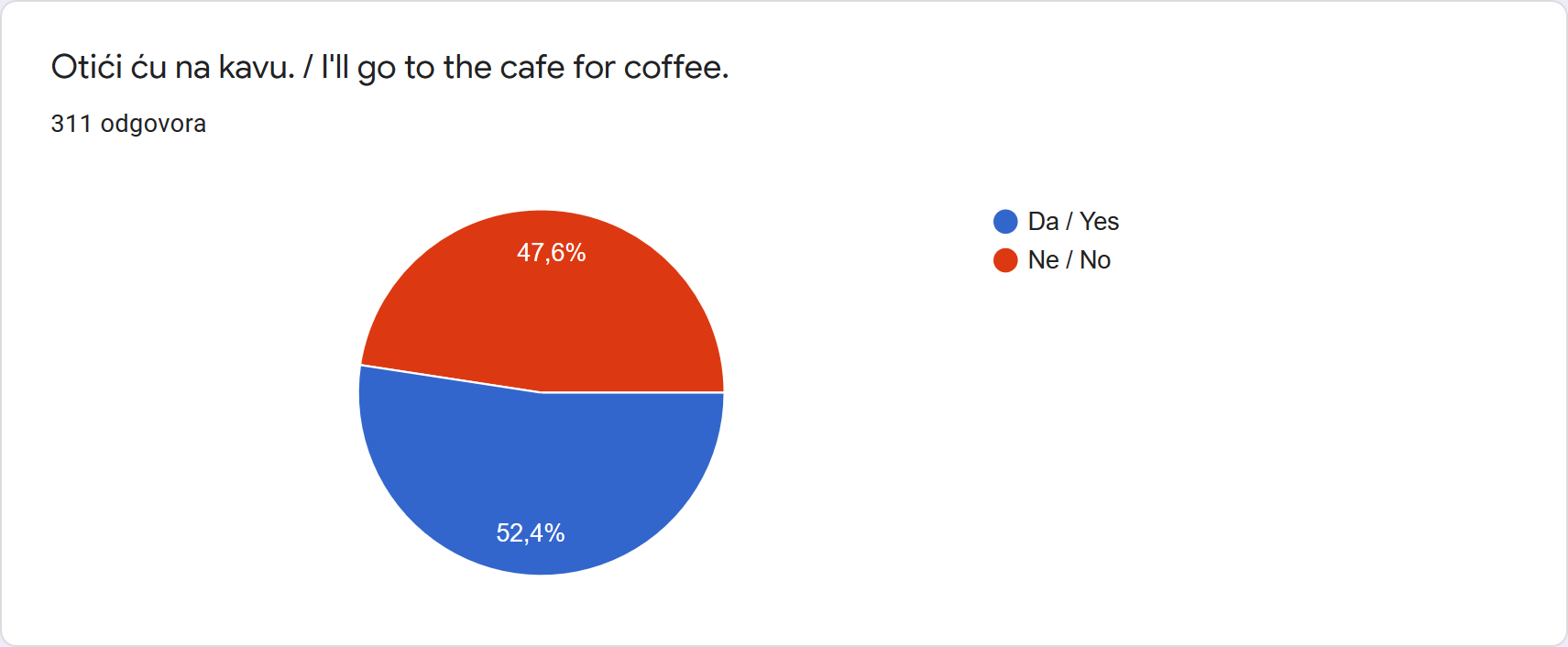
They are even less ready to leave their county, with a total of 55% negative answers.
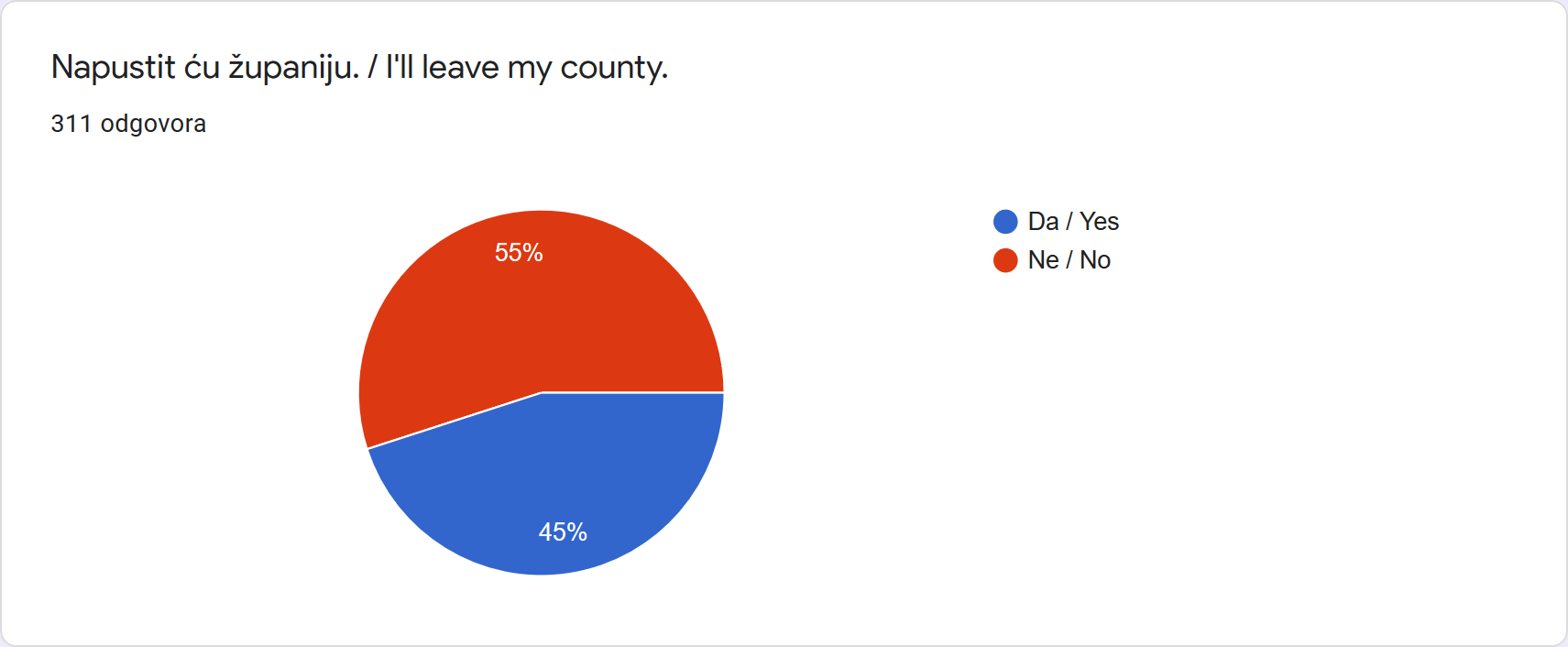
But, when it comes to visiting friends, here, the "yes" answer confidently wins with a total of 71,4%.
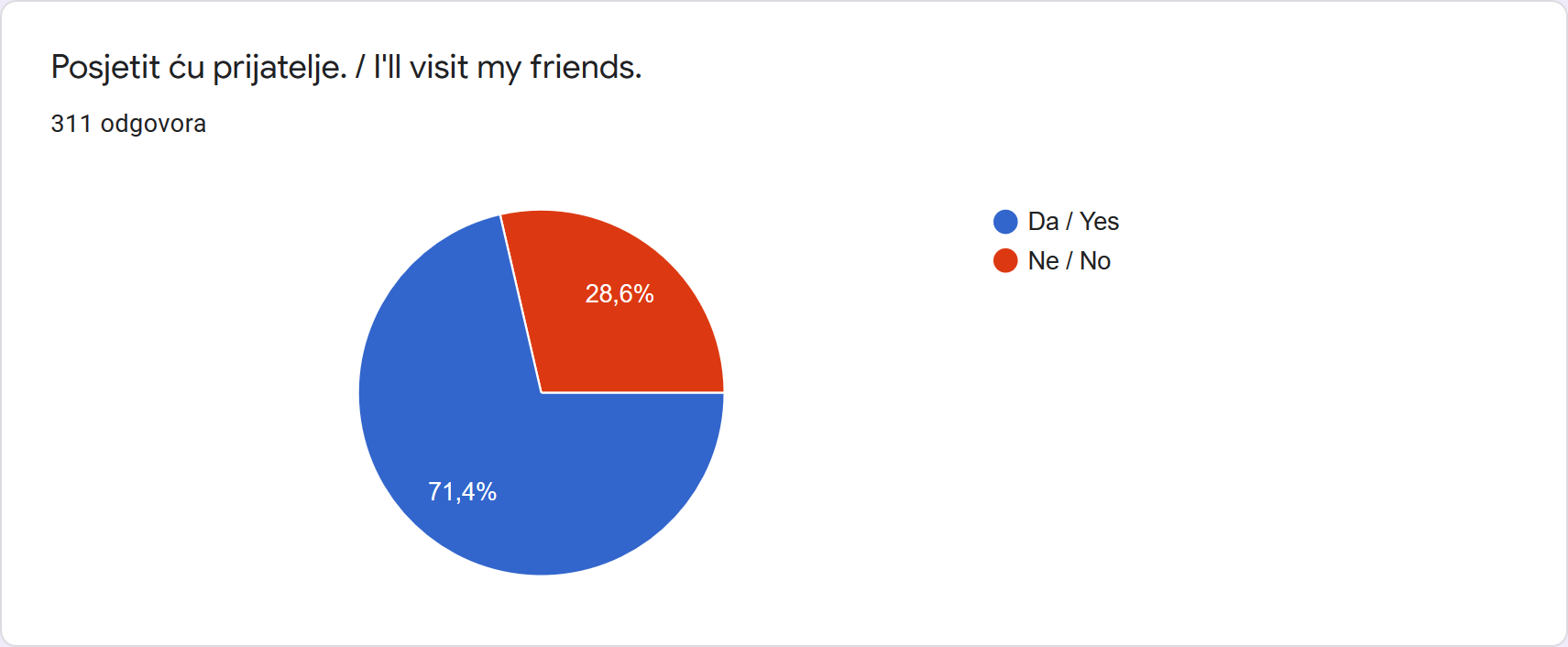
The caution when it comes to shopping is still here - 70,4% of people said they wouldn't go to shopping centers.
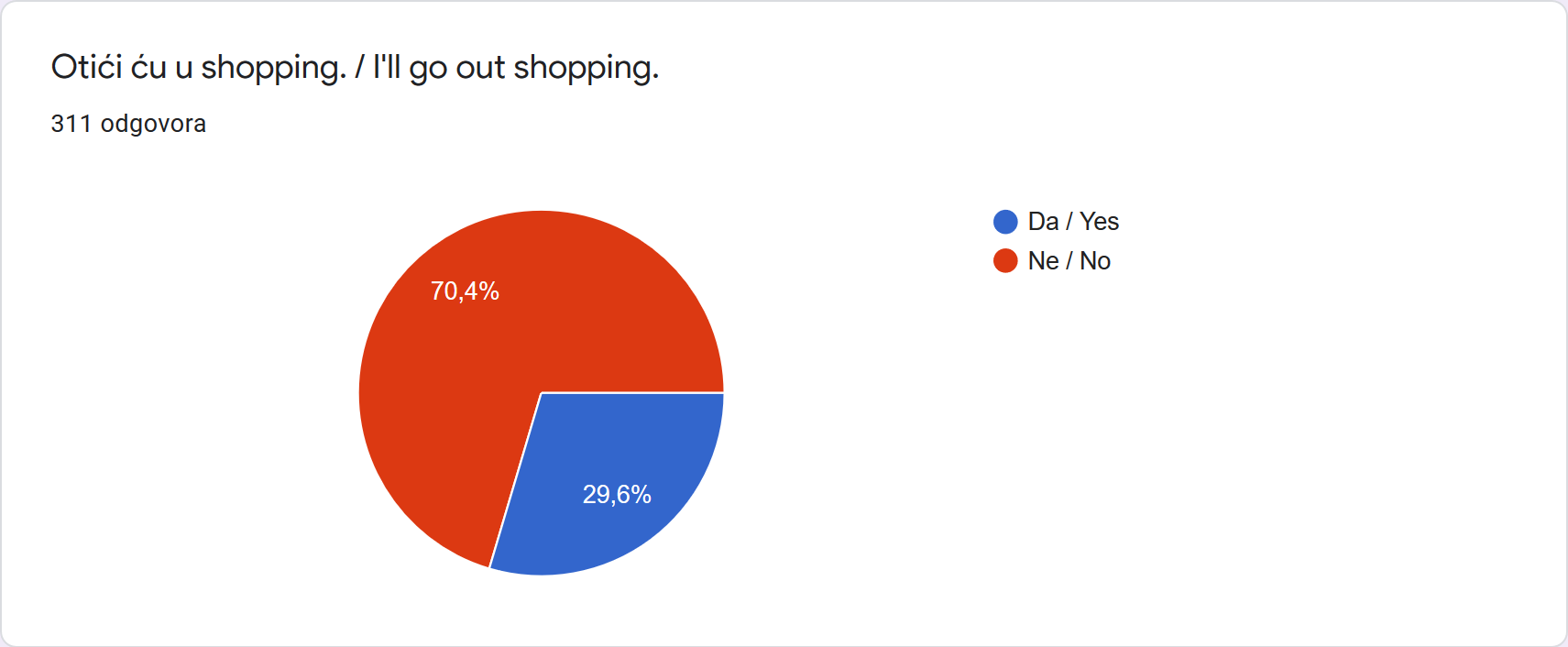
A little less than half of the people answered that they wouldn't stay home, which, after almost two months without that luxury, is understandable.
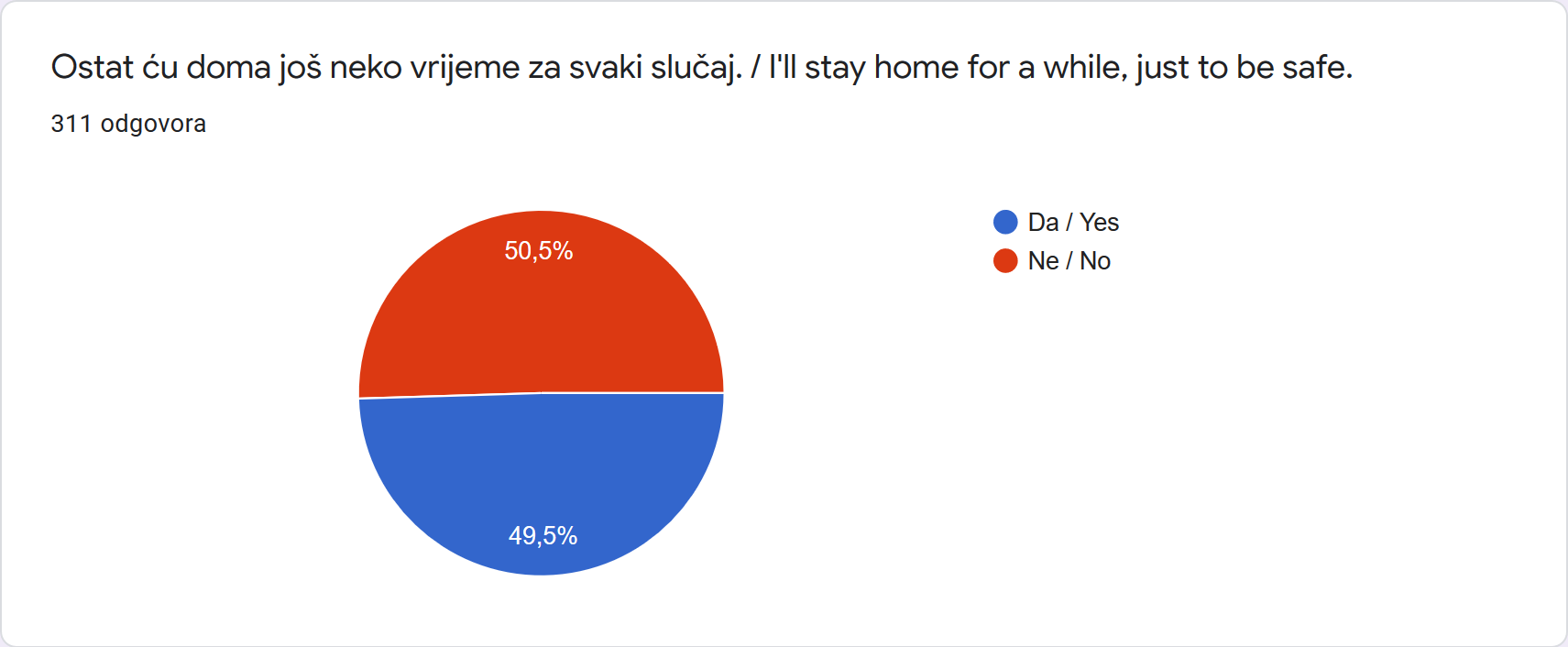
In the last statement, Croats showed responsibility once more - a total of 82,3% of people steal the show.
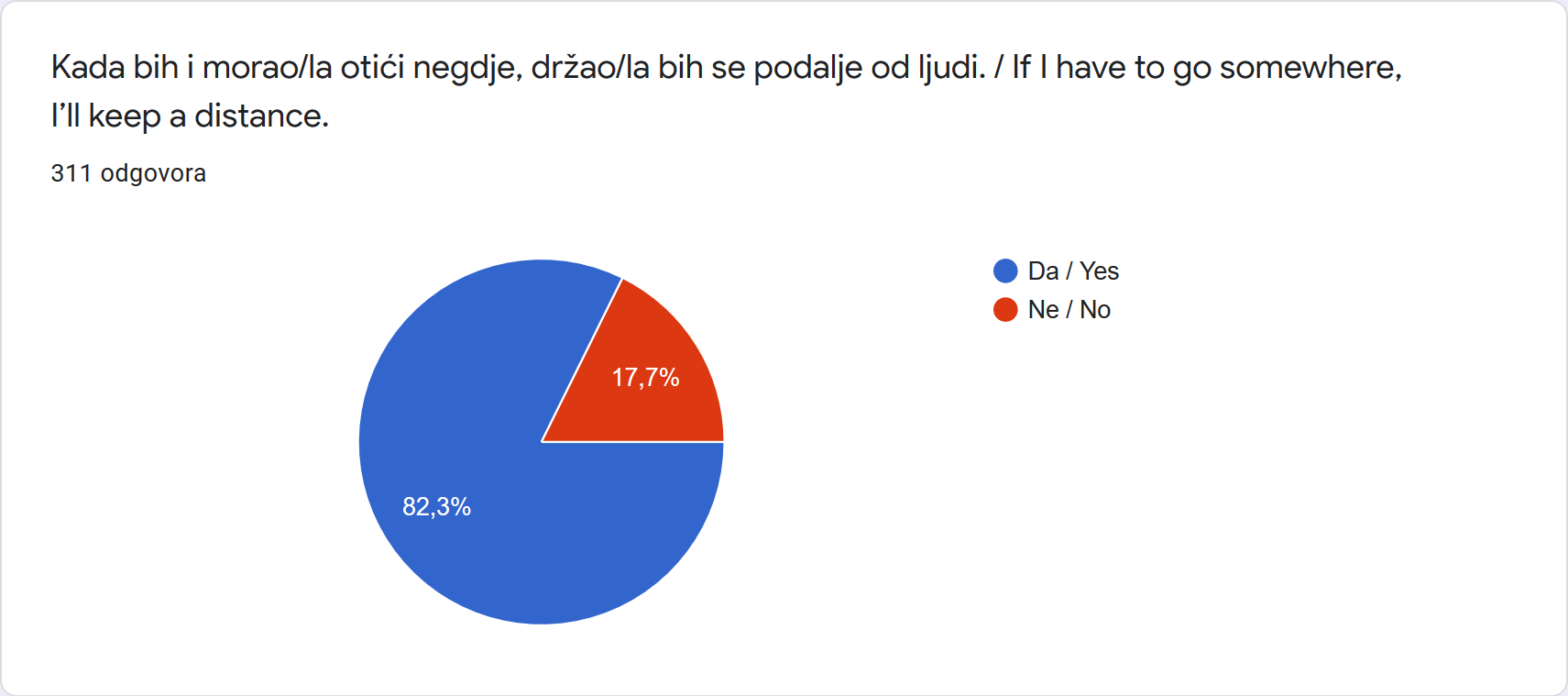
A little reminder for everyone: from tomorrow, gatherings of 40 people will be allowed, and e-passes are eliminated. Still, we are called to act responsibly.
Follow our live updates on the coronavirus crisis in Croatia.
Dubrovnik Hopes Special Status, Ad Campaign Will Save Dismal Tourist Season
May 2, 2020 — Dubrovnik will try to salvage what promises to be a brutal summer tourist season by seeking special status to bypass some travel restrictions while the city’s Tourist Board launches a promotional campaign luring guests back to the Pearl of the Adriatic.
Mayor Mato Franković predicted 2020 may be Dubrovnik’s most uncertain summer season since the 1990s war. He predicted a complete economic collapse if flights remain grounded throughout the summer, with 80 percent of the economy evaporating by spring 2021.
The mayor and city’s Economic Council asked the Croatian government to grant Dubrovnik special status to bypass epidemiological travel restrictions so at least affluent guests can visit. They sent a letter to Prime Minister Andrej Plenković and Tourism Minister Gari Cappelli requesting a green light for charter flights, especially from the U.K., as well as private jets and mega yachts.
Only tourists with a negative test result administered in the last 48 hours would enter, according to the proposal.
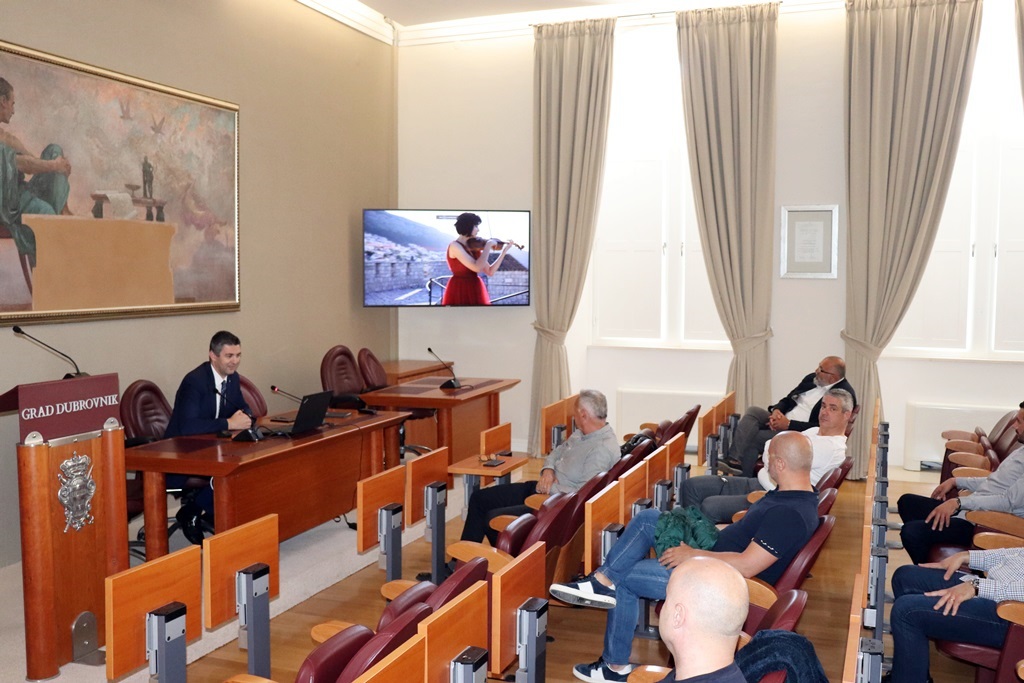
Dubrovnik Mayor Mato Franković said a summer without inbound flights will devastate the local economy.
The 2020 summer season remains uncertain for Croatia. Even the most optimistic forecasts predict plummeting revenues, with some estimates dipping as low as 80 percent of 2019’s bonanza. Still, the tourism-dependent nation began seeking ways to reopen borders without setting off another wave of infections.
Croatia’s measures start at home. The government expects free movement within the country will resume soon so Croats can head to the coast to visit family or second homes.
Cappelli has also pushed for opening borders with neighboring countries — if the virus allows. Plenković’s government hopes Croatia can maintain its draw as an automotive destination for nearby states such as Czechia, Hungary, and Austria, reducing its reliance on arrivals from further across the European continent, Asia and Doha.
The benefits of such a scheme will bypass Dubrovnik. Many of the city’s guests come via direct flights and cruise ships — not by car. The pandemic halted all non-essential travel.
Dubrovnik Airport’s General Manager Frano Luetić expects a 70 percent drop in traffic this summer.
“We are witnessing something unlike we’ve ever seen in peacetime. We have been left without any traffic,” Luetić said.
Croatia Airlines will resume domestic flights to Dubrovnik on May 11, but that won’t bring the city’s target guests.
The Tourist Board’s ad campaign, “Dubrovnik is not going anywhere, it is waiting for you,” began May 1, hitting social media feeds in Scandinavia, the United Kingdom, Germany, and Slovenia. The promos will also appear in the Croatian market, as well as other markets as airlines resume flights to the Dalmatian coastline.
These plans align with recommendations from experts like Zoran Pejović, who suggests emitting a confident message while reminding disappointed travelers their destination will outlast the virus.
The city has enjoyed some perverse positive press as the spiritual and literal birthplace of quarantine. But its isolation and stay at home orders have worn on locals longing to navigate the Stradun and meet for a coffee.
Dubrovnik has 112 confirmed COVID-19 infections since the pandemic started, with no new cases in the last 24 hours.
The coastal city’s tourism council reduced the Tourist Board’s pay by 15 percent. It then tasked Director Ana Hrnić with re-jiggering the staff and organizational makeup.
Diary of a Split Tour Guide in the Age of Corona - Part 5
April 28, 2020 - Part 5 of Ivica Profaca's Diary of a Split Tour Guide in the Age of Corona - you can start at the beginning here.
Why would any guide wait to see what some European Union body would say? If you are not a news junkie (I confess, I am one), political decisions like those rarely influence our job, except in cases when they regulate some segment of guiding work, such as the licensing issue or something similar. And yet, Coronavirus has brought even those under the spotlight.
A video conference of the EU ministers of tourism was expected to give some answers as to whether or not there would be any tourism this year, and if yes what it would look like. The prospects are bad. Borders are closed, and will stay closed for some time ahead. Big markets such as Germany or the United Kingdom (and some others) don't plan to ease regulations any time soon. In the meantime, new regulations were introduced everywhere for hotels, restaurants and other venues, in some cases strict, in some others a little bit more doable. Tourist boards everywhere are trying to give a message of hope, I was proud to take part in a campaign launched by the Tourist Board of Split. However, all efforts might be limited only to domestic travel, because of that magic word - borders. It's not just about the date some of them might re-open. It's also about the psychology. Let's say borders re-open sometime in June, would you really travel only because of that, even with all precautions taken? I'm not sure, at least not before late August or September.
Here's an example from my calendar. In previous articles, I told you how bookings - those that survived without being cancelled - moved to later dates. Little by little, months that are otherwise extremely busy for guides emptied almost completely. April is gone, May is getting close to that, and now it's June and even July getting empty. Completely understandable, when we know all that I wrote before. The last birds that are still marked are the few cruisers which were scheduled to come to Split, but it's actually just a note on certain dates with almost no chance of happening. Cruising companies which operate those ships just extended their closure period, Holland American Lines till June 30, and P&O Cruises all the way to July 31. The situation is pretty much the same with others. It's not only about cruisers, but a very similar situation is also with airlines. Some encouraging news from Germany or Austria where the media said that Croatia might be a big magnet for travellers went adrift with the extension of anti-Corona measures. The Czech Republic announced borders opening, but with all other countries still locked, where they will travel? Again, maybe later. Plus, not really encouraging for guides licensed for languages other than German or Czech. My regular clients, for example, are Americans, Australians, or Canadians, and they will most likely stay home this year or at least in the next few months. It's just too complicated for them to travel that far. Plus, with a terrible situation still raging in the USA, for example, who will plan a vacation? And yes, we still don't know what will happen with the virus, when the vaccine will arrive, will there be a second wave later this year, etc. I usually don't whine, but in this case, I'm just being realistic.
Some of my fellow guides have even bigger problems. If they are registered for seasonal business, they can't count on state help for March, April and May, so will be left almost completely without any income this year. Since they have their businesses open hoping for some aid in the following months, or any kind of job, they can apply for unemployment help. Even us with year-round businesses might be left dry after three months we received or will receive aid aiming to preserve jobs. There are no signs those three months will be extended after May, and most of us will not have a single kuna of income in June and July, probably August too.
So, what's left? Let's try with some optimism. Hopes for September and later months are still open, for now. And yes, domestic travels within Croatian borders. Fortunately, we live in a country which has so much to offer to enjoy. I wrote already about my initial traveling plans (yes, guides do travel during summer) of walking along the Hadrian's Wall in England. It's most likely not going to happen, but if I will be able to afford it, why not do some long walking on island Brač? Not to mention discovering other islands, or equally attractive hinterland.
Counting on changing of habits, recently I translated my AirBnB tours description to Croatian, there is always a chance someone might be interested in some of those tours, although Croatian tourists traveling in their home country rarely hire a guide. This might be their chance, too.
Svi ste dobrodošli.
We will be following Ivica Profaca's journey through the rocky weeks ahead.
If you find yourself in Split, or are planning a post-corona visit, check out his range of tours on his website - families, look out for the kids tour of Diocletian Palace. It will not only entertain your kids while allowing you to absorb this unique UNESCO World Heritage Site, but it will bring out the inner child in you too. Learn more about it here.
You can read other parts of Ivica's Split Tour Guide in the Age of Corona series here.
(To be continued)
COVID-19 in Croatia: Recommendations for Public Transportation Published
April 25, 2020 - The Croatian Institute of Public Health has issued recommendations for the transportation of passengers by trams and buses in Croatia during the coronavirus pandemic.
Index.hr reports that the recommendations are in place to protect drivers and passengers, including driver's hygiene, driving with masks, physical distance and passenger space.
The hygiene of the driver's area and his work environment is maintained by cleaning the surfaces daily with surface disinfectant. In particular, areas that are often touched by hands such as door handles, the steering wheel, worktop, and shelf for ticketing should be cleaned.
The driver is advised to wear a mask while driving if it does not interfere with safe driving. The protective mask should be changed regularly, and always when it becomes moist and wet. If possible, passengers should wear protective masks if it does not affect their breathing.
Before and after removing the mask, hands should be washed with warm water and soap or disinfected. Used disposable masks are disposed of in garbage bags that are placed in buckets with a lid.
Regular hand hygiene is required and, whenever possible, you are to wash your hands with soap and water for 20 seconds. If this is not possible, disinfectants containing 70 percent alcohol are used.
Hands should be washed before entering and after leaving the vehicle, after cleaning the vehicle or when the hands are visibly dirty and in other recommended situations (after using the toilet, before eating, after wiping the nose).
The disinfectant must be available at the entrance to the vehicle, and at the entrance to the bus and tram, hand sanitation is required for the vehicle staff and passengers.
Hands, eyes, mouth and nose should not be touched because the virus can enter the body in this way, close contact with passengers and their luggage should be avoided when communicating with them, and a distance of one to two meters in daily social contact with passengers and others should be maintained. If drivers place luggage in the luggage compartment, then the hands should be disinfected afterward.
Passengers should be informed of the importance of maintaining a distance of at least one meter from each other. Precautions should be observed, especially if passengers with respiratory symptoms are observed.
The number and arrangement of passengers on the tram should be such as to allow the prescribed distance between them. It is advisable to limit the number of passengers in the tram to the number of seats.
On buses, the number and arrangement of passengers in the seats are such that they allow a prescribed distance between them. One person should be seated in a row so that they sit alternately in the left and right seats.
The recommendations also highlight the importance of being aware of the way the coronavirus is transmitted - when an infected person speaks, coughs or sneezes near a healthy person or by touching objects and surfaces contaminated with the respiratory secretions of an infected person, and then by touching the eyes, nose or mouth.
Therefore, it is also necessary to maintain hygiene - cover your mouth with the inside of your elbow or paper handkerchief when coughing or sneezing and then throw the handkerchief in the waste bin and wash your hands.
Regular cleaning and ventilation of the interior of the vehicle before and after driving is required. When cleaning the inside of buses and trams, special attention should be paid to window glass and handrails.
When stopping at stops, it is necessary to ventilate the passenger compartment regularly. While driving, the inside of the bus can be ventilated, but in trams and buses, it is necessary to avoid the use of air conditioning and heating.
It is recommended that windows be opened while driving, weather and temperature permitting.
Payment for tickets should be encouraged with contactless cards or bought online, and if a classic card payment or cash is used, disinfect hands after payment.
Controllers must wear a mouth and nose mask when in contact with passengers, and use disposable gloves, which must be disinfected or changed after each tram is visited, and the mask must be changed regularly as recommended.
Also, it is recommended that buses set up a physical barrier between the driver's seat and the passenger (Plexiglas or similar), and if this is not possible, the front row of seats behind the driver will not be used to transport passengers.
If driving staff or their family members develop symptoms suggestive of COVID-19, such as fever, sore throat, coughing, difficulty breathing, they should not go to work and notify their employer immediately.
The HZJZ points out that most of the recommendations of hygiene measures can be applied to other forms of organized road transport.
The latest recommendations can be found on the HZJZ website, and recommendations for the transportation of passengers on buses and trams provide instructions for using hand sanitizer.
As of Monday, when public and suburban public transport is reintroduced, ZET in Zagreb will launch 111 bus routes according to a custom timetable.
Thus, instead of trams in traffic, there will still be bus lines operating the routes of night tram lines (31 Crnomerec - Savski most, 32 Prečko - Borongaj, 33 Gracansko Dolje - Savišće and 34 Ljubljanica - Dubec). Tramlines will be gradually established, depending on safety assessments and the condition of the lanes they cross, ZET reported on Friday.
In order to comply with epidemiological measures, it is recommended to wear protective masks, hand disinfection, and keeping a social distance.
As of Monday, April 27, public transport of passengers on scheduled routes with the payment of tickets is restored in Split, and accordingly, the transport on special lines ceases, which was free of charge with the presentation of passes or civil protection cards.
"As of Monday, all Promet d.o.o. from Split it will operate at normal business hours, and tickets will also be available on buses from the driver. As regular public transport was abolished on March 22, all passengers who purchased the March stamps have the right to travel with this ticket until Sunday, May 10. All passengers who buy a ticket for May may be stamped with number 4 instead of 5. Namely, in order to reduce operating costs, the stamp will be used which was printed for April, but due to the interruption of bus operations, they were not put on sale," said Promet Split.
To read more about travel in Croatia, follow TCN's dedicated page.
Croatian Restaurants Say Coronavirus Measures Jeopardize Business
April 24, 2020 — Croatian life began a slow march towards normalcy, with the announcement of incrementally-relaxed restrictions over the coming weeks. Restaurants and cafes claim the government's current plan will tank their business, hoping a return to normal comes sooner than expected.
Dalmatian restauranteurs said in interviews they will not have Plexiglas dividers in their establishments, nor will transparent barriers line their terraces this summer.
The Civil Protection Directorate's 11-point list of anti-coronavirus measures taking force on May 11 will increase costs, sink revenues and ruin guest's experiences, they argue, adding it's not even worth opening.
Most said they would prefer to keep their facilities closed until regulations soften, after which they would respond in two days by opening the facilities.
"Last year, at this time, we already had a lot of work and money," one caterer told Slobodna Dalmacija. "This year, we don't even make plans, everything stops."
The new measures would send operating costs skyrocketing, the source added. "A glass of water with coffee or lunch becomes too expensive for us. Because that glass of water now needs to be disinfected, sterilized. We're destroyed now."
Dalmatian chef Pero Savanović said the measures were unacceptable. In his tavern "Mediteran" in Primosten, guests usually sit packed tightly, with backs nearly touching.
"I cannot agree to the measures that are now set as the ultimatum," he said. "By adopting these XXXL measures, we are in a position of unprofitable business.
"At this time last year we were already working full steam," Savanović added. "This year we will wait until the last moment, hoping that someone above, from the decision-makers, will realize that we cannot work on the guest screening system."
A thinning crowd is just one problem. The added costs make the measures unmanageable. Savanović pegged the cost of plexiglass barriers for his terrace at HRK 100,000.
Still, many hope the coronavirus will subside, borders will reopen and tourists will come. Even in this scenario, Savanovic suggests the domestic guest may be key.
Even in the best-case scenario of all wealthy Croats dropping wads of kunas at every meal, Savanović said he'll have to cut staff. The price of labor will be reduced. Food and drink would be cheaper. And a new value system will be established in the catering market.
Savanovic said the measures are made by robots who are just waiting to have a chip installed. Restaurants do not serve a biological need for sustenance, but a social one. Plexiglass, Savanović said, makes this impossible.
"Even in the best conditions, only family restaurants will survive, and those with a quality offer," he said. "There will be order in the chaos, everything that was created for fast profits, poor quality, bad, will fall out of the game."
Well-known chef Duje Pisac said the coronavirus made an unholy mess. Even the luxury heritage hotel in Brac, which is filled by a deep-pocketed clientele has not opened its doors. If the measures are strict, they probably won't.
"How do you arrange breakfast under such conditions? It's hard," Pisac said. "How do you ensure physical distance at the pool? No way. Measures as they are now, and as announced, are deadly for us hospitality and hospitality workers."
He echoed Savanović's issues with the Plexiglass but also suggested wait staff dressed as surgeons won't help either. "Waiters' gloves? Yes, fine. But masks? I can accept them, but then it's not the same. It immediately alludes to danger, to distress."


